Eco-Innovation's Role in Sustainable Marketing: A Detailed Analysis
VerifiedAdded on 2023/04/19
|22
|10565
|176
Report
AI Summary
This report investigates the critical role of eco-innovation in implementing sustainable marketing strategies. It begins by establishing a foundation in sustainability, eco-innovation, and sustainable marketing, highlighting their importance for business and environmental well-being. The report identifies the implementation constraints of sustainable marketing, including market, operational, and corporate image challenges. It then explores eco-innovation as a potential solution, aiming to detail its role in mitigating these challenges. The research questions address the constraints of sustainable marketing, the feasibility of eco-innovation as a solution, and how eco-innovation can solve existing problems. The scope of the study emphasizes the benefits of adopting eco-innovation for firms, including improved marketing efficiency, increased CSR efforts, and potential for future research and technological advancements. The limitations include budget and schedule constraints, as well as the academic researcher's approach. The report aims to provide valuable insights for businesses seeking to enhance their sustainable marketing practices through eco-innovation.
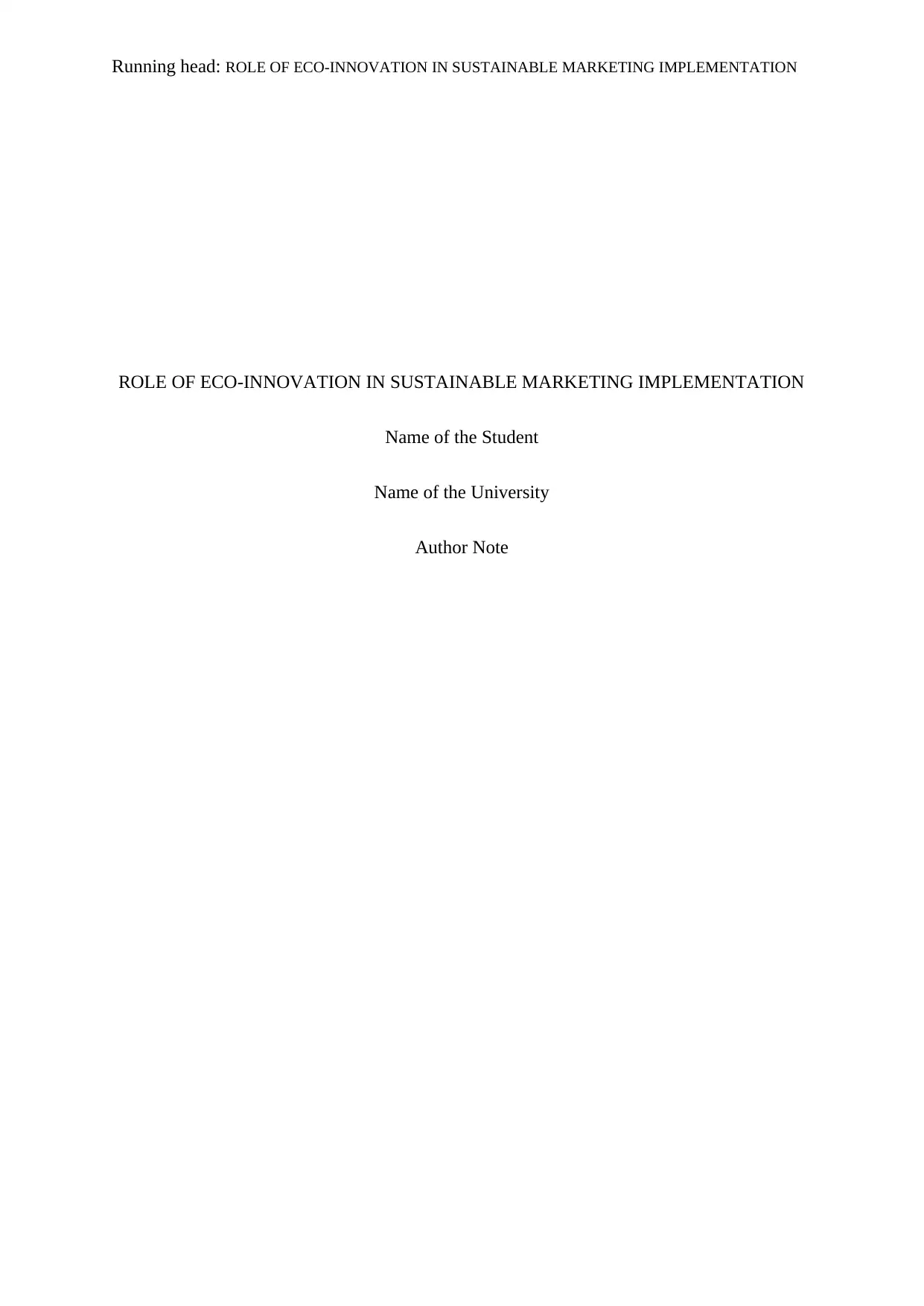
Running head: ROLE OF ECO-INNOVATION IN SUSTAINABLE MARKETING IMPLEMENTATION
ROLE OF ECO-INNOVATION IN SUSTAINABLE MARKETING IMPLEMENTATION
Name of the Student
Name of the University
Author Note
ROLE OF ECO-INNOVATION IN SUSTAINABLE MARKETING IMPLEMENTATION
Name of the Student
Name of the University
Author Note
Paraphrase This Document
Need a fresh take? Get an instant paraphrase of this document with our AI Paraphraser
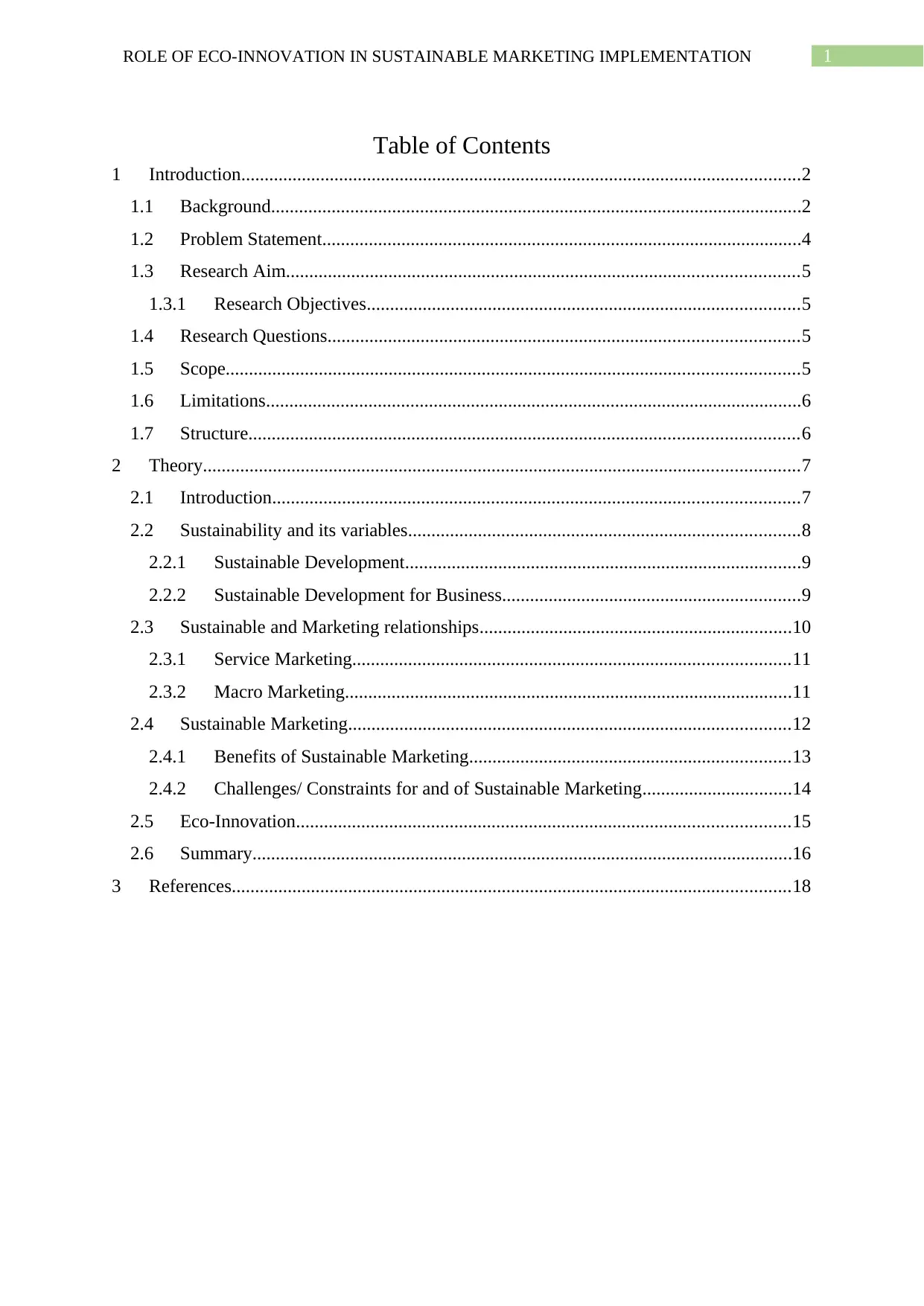
1ROLE OF ECO-INNOVATION IN SUSTAINABLE MARKETING IMPLEMENTATION
Table of Contents
1 Introduction........................................................................................................................2
1.1 Background..................................................................................................................2
1.2 Problem Statement.......................................................................................................4
1.3 Research Aim..............................................................................................................5
1.3.1 Research Objectives.............................................................................................5
1.4 Research Questions.....................................................................................................5
1.5 Scope...........................................................................................................................5
1.6 Limitations...................................................................................................................6
1.7 Structure......................................................................................................................6
2 Theory................................................................................................................................7
2.1 Introduction.................................................................................................................7
2.2 Sustainability and its variables....................................................................................8
2.2.1 Sustainable Development.....................................................................................9
2.2.2 Sustainable Development for Business................................................................9
2.3 Sustainable and Marketing relationships...................................................................10
2.3.1 Service Marketing..............................................................................................11
2.3.2 Macro Marketing................................................................................................11
2.4 Sustainable Marketing...............................................................................................12
2.4.1 Benefits of Sustainable Marketing.....................................................................13
2.4.2 Challenges/ Constraints for and of Sustainable Marketing................................14
2.5 Eco-Innovation..........................................................................................................15
2.6 Summary....................................................................................................................16
3 References........................................................................................................................18
Table of Contents
1 Introduction........................................................................................................................2
1.1 Background..................................................................................................................2
1.2 Problem Statement.......................................................................................................4
1.3 Research Aim..............................................................................................................5
1.3.1 Research Objectives.............................................................................................5
1.4 Research Questions.....................................................................................................5
1.5 Scope...........................................................................................................................5
1.6 Limitations...................................................................................................................6
1.7 Structure......................................................................................................................6
2 Theory................................................................................................................................7
2.1 Introduction.................................................................................................................7
2.2 Sustainability and its variables....................................................................................8
2.2.1 Sustainable Development.....................................................................................9
2.2.2 Sustainable Development for Business................................................................9
2.3 Sustainable and Marketing relationships...................................................................10
2.3.1 Service Marketing..............................................................................................11
2.3.2 Macro Marketing................................................................................................11
2.4 Sustainable Marketing...............................................................................................12
2.4.1 Benefits of Sustainable Marketing.....................................................................13
2.4.2 Challenges/ Constraints for and of Sustainable Marketing................................14
2.5 Eco-Innovation..........................................................................................................15
2.6 Summary....................................................................................................................16
3 References........................................................................................................................18
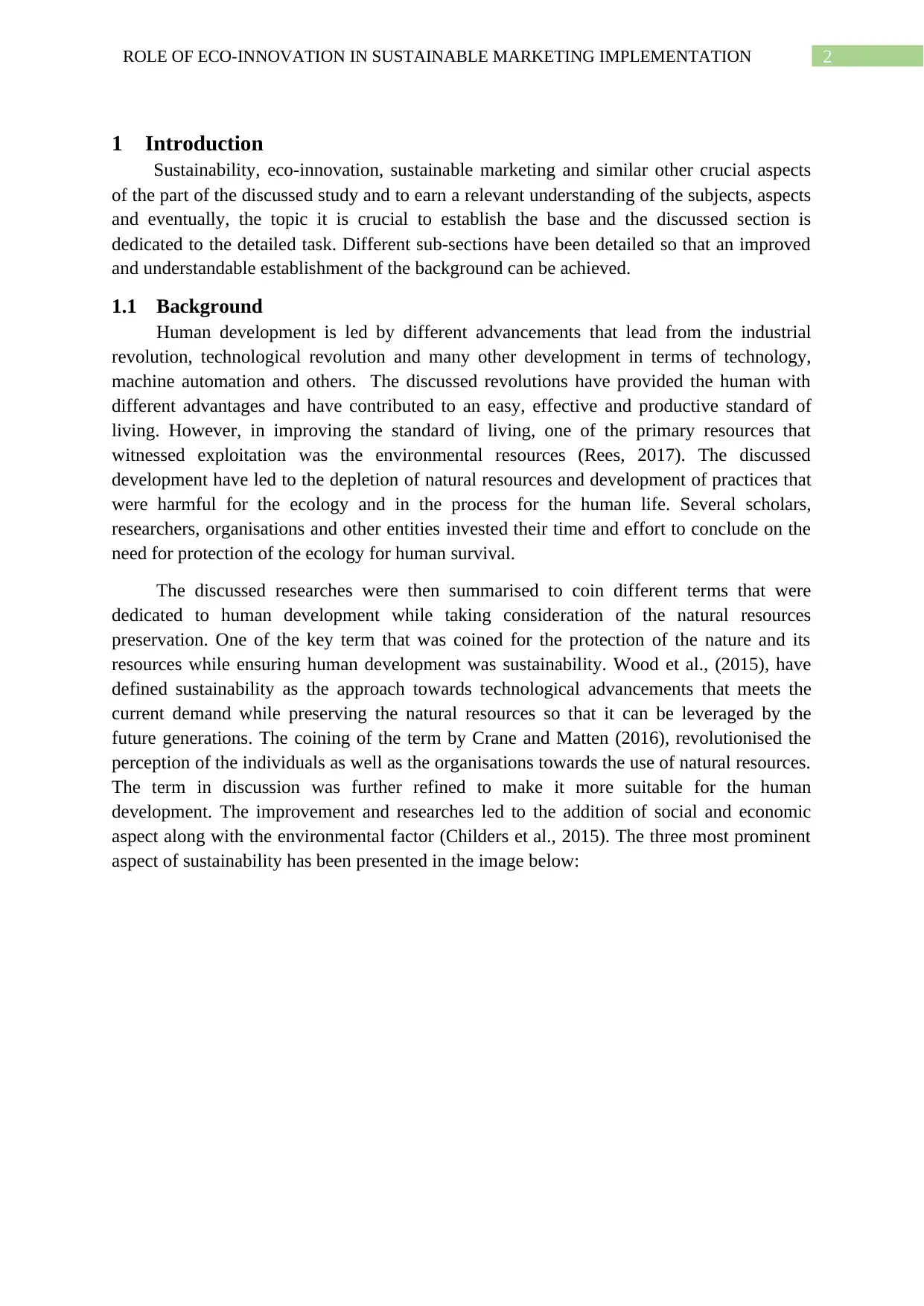
2ROLE OF ECO-INNOVATION IN SUSTAINABLE MARKETING IMPLEMENTATION
1 Introduction
Sustainability, eco-innovation, sustainable marketing and similar other crucial aspects
of the part of the discussed study and to earn a relevant understanding of the subjects, aspects
and eventually, the topic it is crucial to establish the base and the discussed section is
dedicated to the detailed task. Different sub-sections have been detailed so that an improved
and understandable establishment of the background can be achieved.
1.1 Background
Human development is led by different advancements that lead from the industrial
revolution, technological revolution and many other development in terms of technology,
machine automation and others. The discussed revolutions have provided the human with
different advantages and have contributed to an easy, effective and productive standard of
living. However, in improving the standard of living, one of the primary resources that
witnessed exploitation was the environmental resources (Rees, 2017). The discussed
development have led to the depletion of natural resources and development of practices that
were harmful for the ecology and in the process for the human life. Several scholars,
researchers, organisations and other entities invested their time and effort to conclude on the
need for protection of the ecology for human survival.
The discussed researches were then summarised to coin different terms that were
dedicated to human development while taking consideration of the natural resources
preservation. One of the key term that was coined for the protection of the nature and its
resources while ensuring human development was sustainability. Wood et al., (2015), have
defined sustainability as the approach towards technological advancements that meets the
current demand while preserving the natural resources so that it can be leveraged by the
future generations. The coining of the term by Crane and Matten (2016), revolutionised the
perception of the individuals as well as the organisations towards the use of natural resources.
The term in discussion was further refined to make it more suitable for the human
development. The improvement and researches led to the addition of social and economic
aspect along with the environmental factor (Childers et al., 2015). The three most prominent
aspect of sustainability has been presented in the image below:
1 Introduction
Sustainability, eco-innovation, sustainable marketing and similar other crucial aspects
of the part of the discussed study and to earn a relevant understanding of the subjects, aspects
and eventually, the topic it is crucial to establish the base and the discussed section is
dedicated to the detailed task. Different sub-sections have been detailed so that an improved
and understandable establishment of the background can be achieved.
1.1 Background
Human development is led by different advancements that lead from the industrial
revolution, technological revolution and many other development in terms of technology,
machine automation and others. The discussed revolutions have provided the human with
different advantages and have contributed to an easy, effective and productive standard of
living. However, in improving the standard of living, one of the primary resources that
witnessed exploitation was the environmental resources (Rees, 2017). The discussed
development have led to the depletion of natural resources and development of practices that
were harmful for the ecology and in the process for the human life. Several scholars,
researchers, organisations and other entities invested their time and effort to conclude on the
need for protection of the ecology for human survival.
The discussed researches were then summarised to coin different terms that were
dedicated to human development while taking consideration of the natural resources
preservation. One of the key term that was coined for the protection of the nature and its
resources while ensuring human development was sustainability. Wood et al., (2015), have
defined sustainability as the approach towards technological advancements that meets the
current demand while preserving the natural resources so that it can be leveraged by the
future generations. The coining of the term by Crane and Matten (2016), revolutionised the
perception of the individuals as well as the organisations towards the use of natural resources.
The term in discussion was further refined to make it more suitable for the human
development. The improvement and researches led to the addition of social and economic
aspect along with the environmental factor (Childers et al., 2015). The three most prominent
aspect of sustainability has been presented in the image below:
You're viewing a preview
Unlock full access by subscribing today!
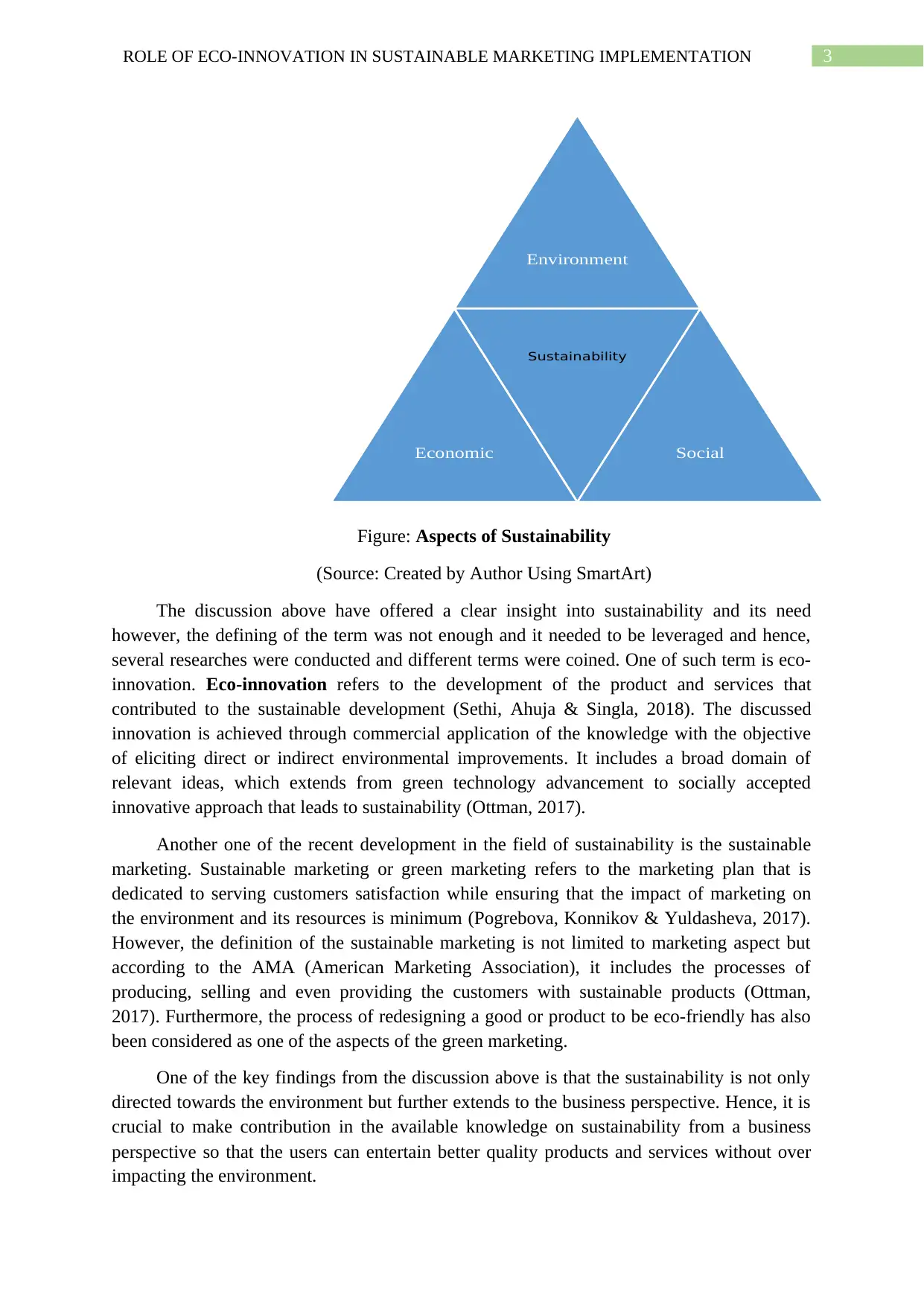
3ROLE OF ECO-INNOVATION IN SUSTAINABLE MARKETING IMPLEMENTATION
Figure: Aspects of Sustainability
(Source: Created by Author Using SmartArt)
The discussion above have offered a clear insight into sustainability and its need
however, the defining of the term was not enough and it needed to be leveraged and hence,
several researches were conducted and different terms were coined. One of such term is eco-
innovation. Eco-innovation refers to the development of the product and services that
contributed to the sustainable development (Sethi, Ahuja & Singla, 2018). The discussed
innovation is achieved through commercial application of the knowledge with the objective
of eliciting direct or indirect environmental improvements. It includes a broad domain of
relevant ideas, which extends from green technology advancement to socially accepted
innovative approach that leads to sustainability (Ottman, 2017).
Another one of the recent development in the field of sustainability is the sustainable
marketing. Sustainable marketing or green marketing refers to the marketing plan that is
dedicated to serving customers satisfaction while ensuring that the impact of marketing on
the environment and its resources is minimum (Pogrebova, Konnikov & Yuldasheva, 2017).
However, the definition of the sustainable marketing is not limited to marketing aspect but
according to the AMA (American Marketing Association), it includes the processes of
producing, selling and even providing the customers with sustainable products (Ottman,
2017). Furthermore, the process of redesigning a good or product to be eco-friendly has also
been considered as one of the aspects of the green marketing.
One of the key findings from the discussion above is that the sustainability is not only
directed towards the environment but further extends to the business perspective. Hence, it is
crucial to make contribution in the available knowledge on sustainability from a business
perspective so that the users can entertain better quality products and services without over
impacting the environment.
Environment
Economic
Sustainability
Social
Figure: Aspects of Sustainability
(Source: Created by Author Using SmartArt)
The discussion above have offered a clear insight into sustainability and its need
however, the defining of the term was not enough and it needed to be leveraged and hence,
several researches were conducted and different terms were coined. One of such term is eco-
innovation. Eco-innovation refers to the development of the product and services that
contributed to the sustainable development (Sethi, Ahuja & Singla, 2018). The discussed
innovation is achieved through commercial application of the knowledge with the objective
of eliciting direct or indirect environmental improvements. It includes a broad domain of
relevant ideas, which extends from green technology advancement to socially accepted
innovative approach that leads to sustainability (Ottman, 2017).
Another one of the recent development in the field of sustainability is the sustainable
marketing. Sustainable marketing or green marketing refers to the marketing plan that is
dedicated to serving customers satisfaction while ensuring that the impact of marketing on
the environment and its resources is minimum (Pogrebova, Konnikov & Yuldasheva, 2017).
However, the definition of the sustainable marketing is not limited to marketing aspect but
according to the AMA (American Marketing Association), it includes the processes of
producing, selling and even providing the customers with sustainable products (Ottman,
2017). Furthermore, the process of redesigning a good or product to be eco-friendly has also
been considered as one of the aspects of the green marketing.
One of the key findings from the discussion above is that the sustainability is not only
directed towards the environment but further extends to the business perspective. Hence, it is
crucial to make contribution in the available knowledge on sustainability from a business
perspective so that the users can entertain better quality products and services without over
impacting the environment.
Environment
Economic
Sustainability
Social
Paraphrase This Document
Need a fresh take? Get an instant paraphrase of this document with our AI Paraphraser
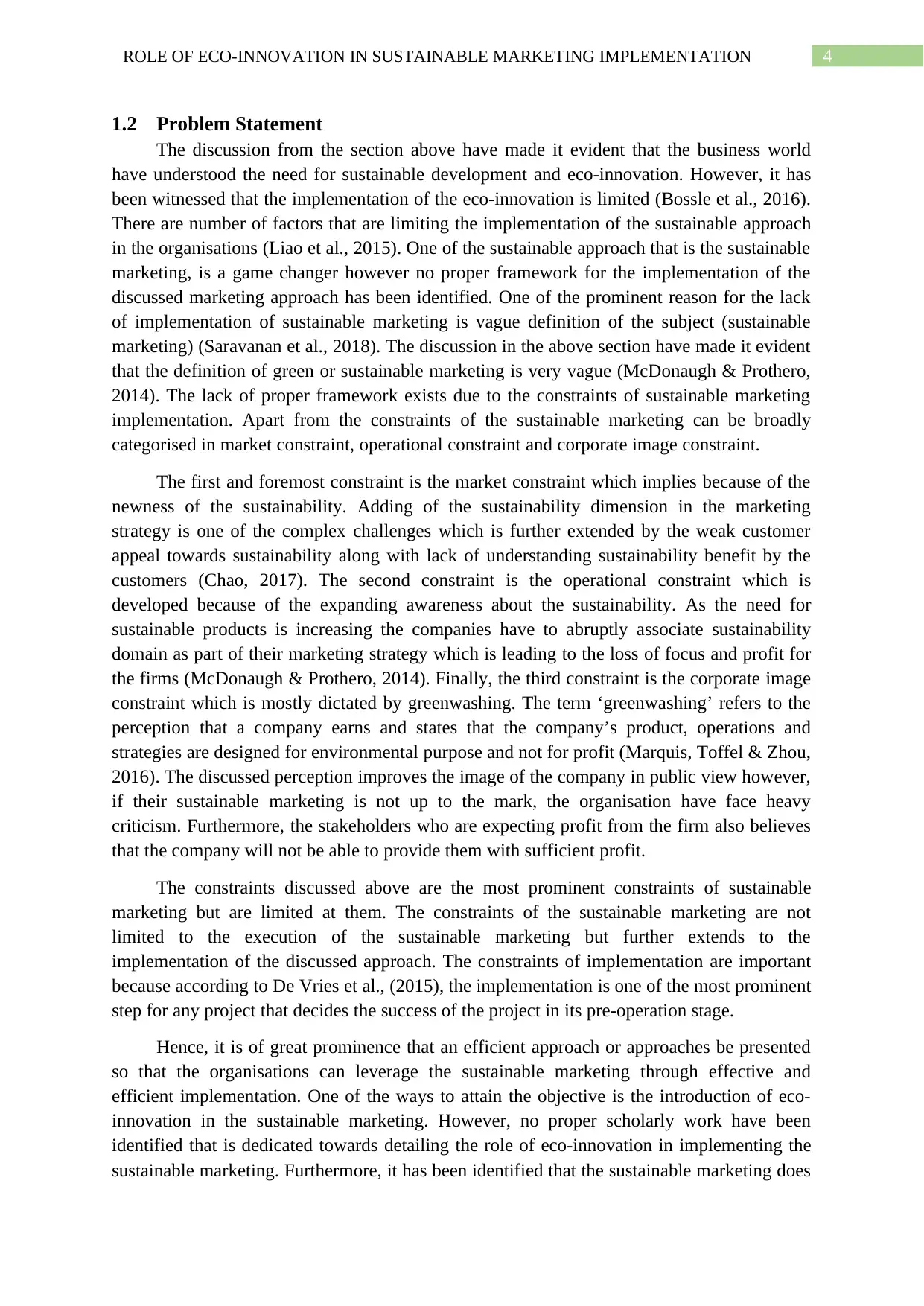
4ROLE OF ECO-INNOVATION IN SUSTAINABLE MARKETING IMPLEMENTATION
1.2 Problem Statement
The discussion from the section above have made it evident that the business world
have understood the need for sustainable development and eco-innovation. However, it has
been witnessed that the implementation of the eco-innovation is limited (Bossle et al., 2016).
There are number of factors that are limiting the implementation of the sustainable approach
in the organisations (Liao et al., 2015). One of the sustainable approach that is the sustainable
marketing, is a game changer however no proper framework for the implementation of the
discussed marketing approach has been identified. One of the prominent reason for the lack
of implementation of sustainable marketing is vague definition of the subject (sustainable
marketing) (Saravanan et al., 2018). The discussion in the above section have made it evident
that the definition of green or sustainable marketing is very vague (McDonaugh & Prothero,
2014). The lack of proper framework exists due to the constraints of sustainable marketing
implementation. Apart from the constraints of the sustainable marketing can be broadly
categorised in market constraint, operational constraint and corporate image constraint.
The first and foremost constraint is the market constraint which implies because of the
newness of the sustainability. Adding of the sustainability dimension in the marketing
strategy is one of the complex challenges which is further extended by the weak customer
appeal towards sustainability along with lack of understanding sustainability benefit by the
customers (Chao, 2017). The second constraint is the operational constraint which is
developed because of the expanding awareness about the sustainability. As the need for
sustainable products is increasing the companies have to abruptly associate sustainability
domain as part of their marketing strategy which is leading to the loss of focus and profit for
the firms (McDonaugh & Prothero, 2014). Finally, the third constraint is the corporate image
constraint which is mostly dictated by greenwashing. The term ‘greenwashing’ refers to the
perception that a company earns and states that the company’s product, operations and
strategies are designed for environmental purpose and not for profit (Marquis, Toffel & Zhou,
2016). The discussed perception improves the image of the company in public view however,
if their sustainable marketing is not up to the mark, the organisation have face heavy
criticism. Furthermore, the stakeholders who are expecting profit from the firm also believes
that the company will not be able to provide them with sufficient profit.
The constraints discussed above are the most prominent constraints of sustainable
marketing but are limited at them. The constraints of the sustainable marketing are not
limited to the execution of the sustainable marketing but further extends to the
implementation of the discussed approach. The constraints of implementation are important
because according to De Vries et al., (2015), the implementation is one of the most prominent
step for any project that decides the success of the project in its pre-operation stage.
Hence, it is of great prominence that an efficient approach or approaches be presented
so that the organisations can leverage the sustainable marketing through effective and
efficient implementation. One of the ways to attain the objective is the introduction of eco-
innovation in the sustainable marketing. However, no proper scholarly work have been
identified that is dedicated towards detailing the role of eco-innovation in implementing the
sustainable marketing. Furthermore, it has been identified that the sustainable marketing does
1.2 Problem Statement
The discussion from the section above have made it evident that the business world
have understood the need for sustainable development and eco-innovation. However, it has
been witnessed that the implementation of the eco-innovation is limited (Bossle et al., 2016).
There are number of factors that are limiting the implementation of the sustainable approach
in the organisations (Liao et al., 2015). One of the sustainable approach that is the sustainable
marketing, is a game changer however no proper framework for the implementation of the
discussed marketing approach has been identified. One of the prominent reason for the lack
of implementation of sustainable marketing is vague definition of the subject (sustainable
marketing) (Saravanan et al., 2018). The discussion in the above section have made it evident
that the definition of green or sustainable marketing is very vague (McDonaugh & Prothero,
2014). The lack of proper framework exists due to the constraints of sustainable marketing
implementation. Apart from the constraints of the sustainable marketing can be broadly
categorised in market constraint, operational constraint and corporate image constraint.
The first and foremost constraint is the market constraint which implies because of the
newness of the sustainability. Adding of the sustainability dimension in the marketing
strategy is one of the complex challenges which is further extended by the weak customer
appeal towards sustainability along with lack of understanding sustainability benefit by the
customers (Chao, 2017). The second constraint is the operational constraint which is
developed because of the expanding awareness about the sustainability. As the need for
sustainable products is increasing the companies have to abruptly associate sustainability
domain as part of their marketing strategy which is leading to the loss of focus and profit for
the firms (McDonaugh & Prothero, 2014). Finally, the third constraint is the corporate image
constraint which is mostly dictated by greenwashing. The term ‘greenwashing’ refers to the
perception that a company earns and states that the company’s product, operations and
strategies are designed for environmental purpose and not for profit (Marquis, Toffel & Zhou,
2016). The discussed perception improves the image of the company in public view however,
if their sustainable marketing is not up to the mark, the organisation have face heavy
criticism. Furthermore, the stakeholders who are expecting profit from the firm also believes
that the company will not be able to provide them with sufficient profit.
The constraints discussed above are the most prominent constraints of sustainable
marketing but are limited at them. The constraints of the sustainable marketing are not
limited to the execution of the sustainable marketing but further extends to the
implementation of the discussed approach. The constraints of implementation are important
because according to De Vries et al., (2015), the implementation is one of the most prominent
step for any project that decides the success of the project in its pre-operation stage.
Hence, it is of great prominence that an efficient approach or approaches be presented
so that the organisations can leverage the sustainable marketing through effective and
efficient implementation. One of the ways to attain the objective is the introduction of eco-
innovation in the sustainable marketing. However, no proper scholarly work have been
identified that is dedicated towards detailing the role of eco-innovation in implementing the
sustainable marketing. Furthermore, it has been identified that the sustainable marketing does
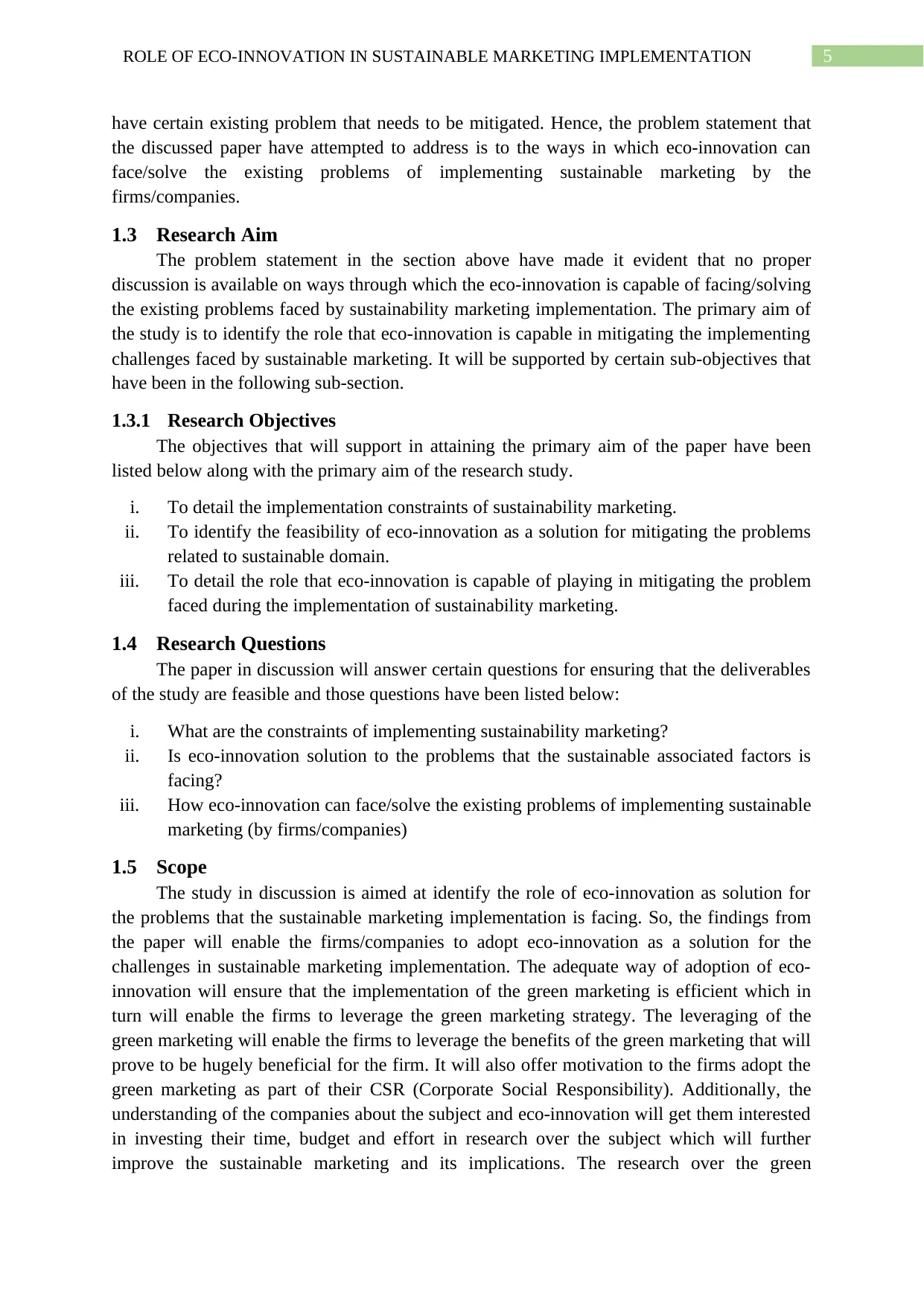
5ROLE OF ECO-INNOVATION IN SUSTAINABLE MARKETING IMPLEMENTATION
have certain existing problem that needs to be mitigated. Hence, the problem statement that
the discussed paper have attempted to address is to the ways in which eco-innovation can
face/solve the existing problems of implementing sustainable marketing by the
firms/companies.
1.3 Research Aim
The problem statement in the section above have made it evident that no proper
discussion is available on ways through which the eco-innovation is capable of facing/solving
the existing problems faced by sustainability marketing implementation. The primary aim of
the study is to identify the role that eco-innovation is capable in mitigating the implementing
challenges faced by sustainable marketing. It will be supported by certain sub-objectives that
have been in the following sub-section.
1.3.1 Research Objectives
The objectives that will support in attaining the primary aim of the paper have been
listed below along with the primary aim of the research study.
i. To detail the implementation constraints of sustainability marketing.
ii. To identify the feasibility of eco-innovation as a solution for mitigating the problems
related to sustainable domain.
iii. To detail the role that eco-innovation is capable of playing in mitigating the problem
faced during the implementation of sustainability marketing.
1.4 Research Questions
The paper in discussion will answer certain questions for ensuring that the deliverables
of the study are feasible and those questions have been listed below:
i. What are the constraints of implementing sustainability marketing?
ii. Is eco-innovation solution to the problems that the sustainable associated factors is
facing?
iii. How eco-innovation can face/solve the existing problems of implementing sustainable
marketing (by firms/companies)
1.5 Scope
The study in discussion is aimed at identify the role of eco-innovation as solution for
the problems that the sustainable marketing implementation is facing. So, the findings from
the paper will enable the firms/companies to adopt eco-innovation as a solution for the
challenges in sustainable marketing implementation. The adequate way of adoption of eco-
innovation will ensure that the implementation of the green marketing is efficient which in
turn will enable the firms to leverage the green marketing strategy. The leveraging of the
green marketing will enable the firms to leverage the benefits of the green marketing that will
prove to be hugely beneficial for the firm. It will also offer motivation to the firms adopt the
green marketing as part of their CSR (Corporate Social Responsibility). Additionally, the
understanding of the companies about the subject and eco-innovation will get them interested
in investing their time, budget and effort in research over the subject which will further
improve the sustainable marketing and its implications. The research over the green
have certain existing problem that needs to be mitigated. Hence, the problem statement that
the discussed paper have attempted to address is to the ways in which eco-innovation can
face/solve the existing problems of implementing sustainable marketing by the
firms/companies.
1.3 Research Aim
The problem statement in the section above have made it evident that no proper
discussion is available on ways through which the eco-innovation is capable of facing/solving
the existing problems faced by sustainability marketing implementation. The primary aim of
the study is to identify the role that eco-innovation is capable in mitigating the implementing
challenges faced by sustainable marketing. It will be supported by certain sub-objectives that
have been in the following sub-section.
1.3.1 Research Objectives
The objectives that will support in attaining the primary aim of the paper have been
listed below along with the primary aim of the research study.
i. To detail the implementation constraints of sustainability marketing.
ii. To identify the feasibility of eco-innovation as a solution for mitigating the problems
related to sustainable domain.
iii. To detail the role that eco-innovation is capable of playing in mitigating the problem
faced during the implementation of sustainability marketing.
1.4 Research Questions
The paper in discussion will answer certain questions for ensuring that the deliverables
of the study are feasible and those questions have been listed below:
i. What are the constraints of implementing sustainability marketing?
ii. Is eco-innovation solution to the problems that the sustainable associated factors is
facing?
iii. How eco-innovation can face/solve the existing problems of implementing sustainable
marketing (by firms/companies)
1.5 Scope
The study in discussion is aimed at identify the role of eco-innovation as solution for
the problems that the sustainable marketing implementation is facing. So, the findings from
the paper will enable the firms/companies to adopt eco-innovation as a solution for the
challenges in sustainable marketing implementation. The adequate way of adoption of eco-
innovation will ensure that the implementation of the green marketing is efficient which in
turn will enable the firms to leverage the green marketing strategy. The leveraging of the
green marketing will enable the firms to leverage the benefits of the green marketing that will
prove to be hugely beneficial for the firm. It will also offer motivation to the firms adopt the
green marketing as part of their CSR (Corporate Social Responsibility). Additionally, the
understanding of the companies about the subject and eco-innovation will get them interested
in investing their time, budget and effort in research over the subject which will further
improve the sustainable marketing and its implications. The research over the green
You're viewing a preview
Unlock full access by subscribing today!
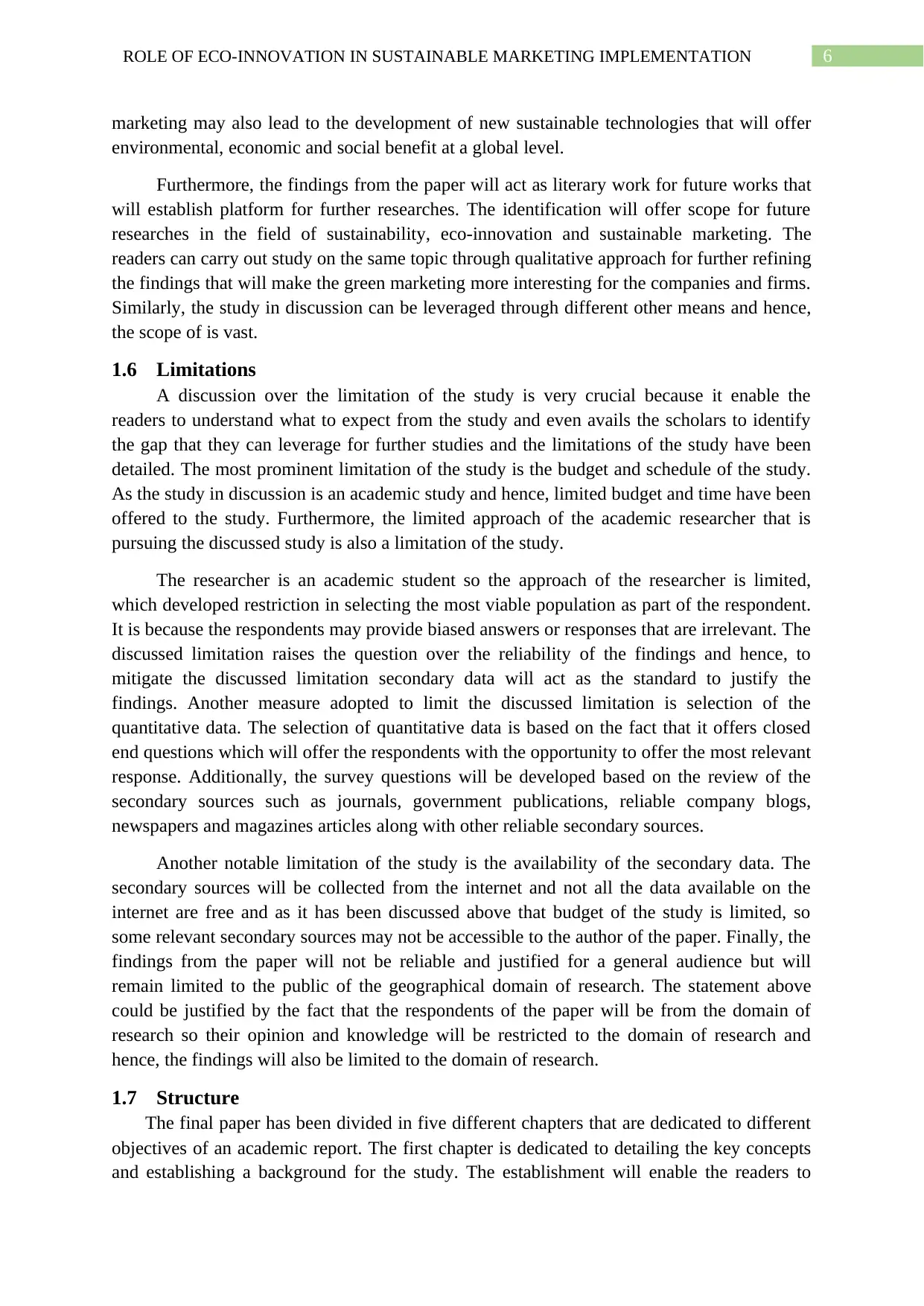
6ROLE OF ECO-INNOVATION IN SUSTAINABLE MARKETING IMPLEMENTATION
marketing may also lead to the development of new sustainable technologies that will offer
environmental, economic and social benefit at a global level.
Furthermore, the findings from the paper will act as literary work for future works that
will establish platform for further researches. The identification will offer scope for future
researches in the field of sustainability, eco-innovation and sustainable marketing. The
readers can carry out study on the same topic through qualitative approach for further refining
the findings that will make the green marketing more interesting for the companies and firms.
Similarly, the study in discussion can be leveraged through different other means and hence,
the scope of is vast.
1.6 Limitations
A discussion over the limitation of the study is very crucial because it enable the
readers to understand what to expect from the study and even avails the scholars to identify
the gap that they can leverage for further studies and the limitations of the study have been
detailed. The most prominent limitation of the study is the budget and schedule of the study.
As the study in discussion is an academic study and hence, limited budget and time have been
offered to the study. Furthermore, the limited approach of the academic researcher that is
pursuing the discussed study is also a limitation of the study.
The researcher is an academic student so the approach of the researcher is limited,
which developed restriction in selecting the most viable population as part of the respondent.
It is because the respondents may provide biased answers or responses that are irrelevant. The
discussed limitation raises the question over the reliability of the findings and hence, to
mitigate the discussed limitation secondary data will act as the standard to justify the
findings. Another measure adopted to limit the discussed limitation is selection of the
quantitative data. The selection of quantitative data is based on the fact that it offers closed
end questions which will offer the respondents with the opportunity to offer the most relevant
response. Additionally, the survey questions will be developed based on the review of the
secondary sources such as journals, government publications, reliable company blogs,
newspapers and magazines articles along with other reliable secondary sources.
Another notable limitation of the study is the availability of the secondary data. The
secondary sources will be collected from the internet and not all the data available on the
internet are free and as it has been discussed above that budget of the study is limited, so
some relevant secondary sources may not be accessible to the author of the paper. Finally, the
findings from the paper will not be reliable and justified for a general audience but will
remain limited to the public of the geographical domain of research. The statement above
could be justified by the fact that the respondents of the paper will be from the domain of
research so their opinion and knowledge will be restricted to the domain of research and
hence, the findings will also be limited to the domain of research.
1.7 Structure
The final paper has been divided in five different chapters that are dedicated to different
objectives of an academic report. The first chapter is dedicated to detailing the key concepts
and establishing a background for the study. The establishment will enable the readers to
marketing may also lead to the development of new sustainable technologies that will offer
environmental, economic and social benefit at a global level.
Furthermore, the findings from the paper will act as literary work for future works that
will establish platform for further researches. The identification will offer scope for future
researches in the field of sustainability, eco-innovation and sustainable marketing. The
readers can carry out study on the same topic through qualitative approach for further refining
the findings that will make the green marketing more interesting for the companies and firms.
Similarly, the study in discussion can be leveraged through different other means and hence,
the scope of is vast.
1.6 Limitations
A discussion over the limitation of the study is very crucial because it enable the
readers to understand what to expect from the study and even avails the scholars to identify
the gap that they can leverage for further studies and the limitations of the study have been
detailed. The most prominent limitation of the study is the budget and schedule of the study.
As the study in discussion is an academic study and hence, limited budget and time have been
offered to the study. Furthermore, the limited approach of the academic researcher that is
pursuing the discussed study is also a limitation of the study.
The researcher is an academic student so the approach of the researcher is limited,
which developed restriction in selecting the most viable population as part of the respondent.
It is because the respondents may provide biased answers or responses that are irrelevant. The
discussed limitation raises the question over the reliability of the findings and hence, to
mitigate the discussed limitation secondary data will act as the standard to justify the
findings. Another measure adopted to limit the discussed limitation is selection of the
quantitative data. The selection of quantitative data is based on the fact that it offers closed
end questions which will offer the respondents with the opportunity to offer the most relevant
response. Additionally, the survey questions will be developed based on the review of the
secondary sources such as journals, government publications, reliable company blogs,
newspapers and magazines articles along with other reliable secondary sources.
Another notable limitation of the study is the availability of the secondary data. The
secondary sources will be collected from the internet and not all the data available on the
internet are free and as it has been discussed above that budget of the study is limited, so
some relevant secondary sources may not be accessible to the author of the paper. Finally, the
findings from the paper will not be reliable and justified for a general audience but will
remain limited to the public of the geographical domain of research. The statement above
could be justified by the fact that the respondents of the paper will be from the domain of
research so their opinion and knowledge will be restricted to the domain of research and
hence, the findings will also be limited to the domain of research.
1.7 Structure
The final paper has been divided in five different chapters that are dedicated to different
objectives of an academic report. The first chapter is dedicated to detailing the key concepts
and establishing a background for the study. The establishment will enable the readers to
Paraphrase This Document
Need a fresh take? Get an instant paraphrase of this document with our AI Paraphraser
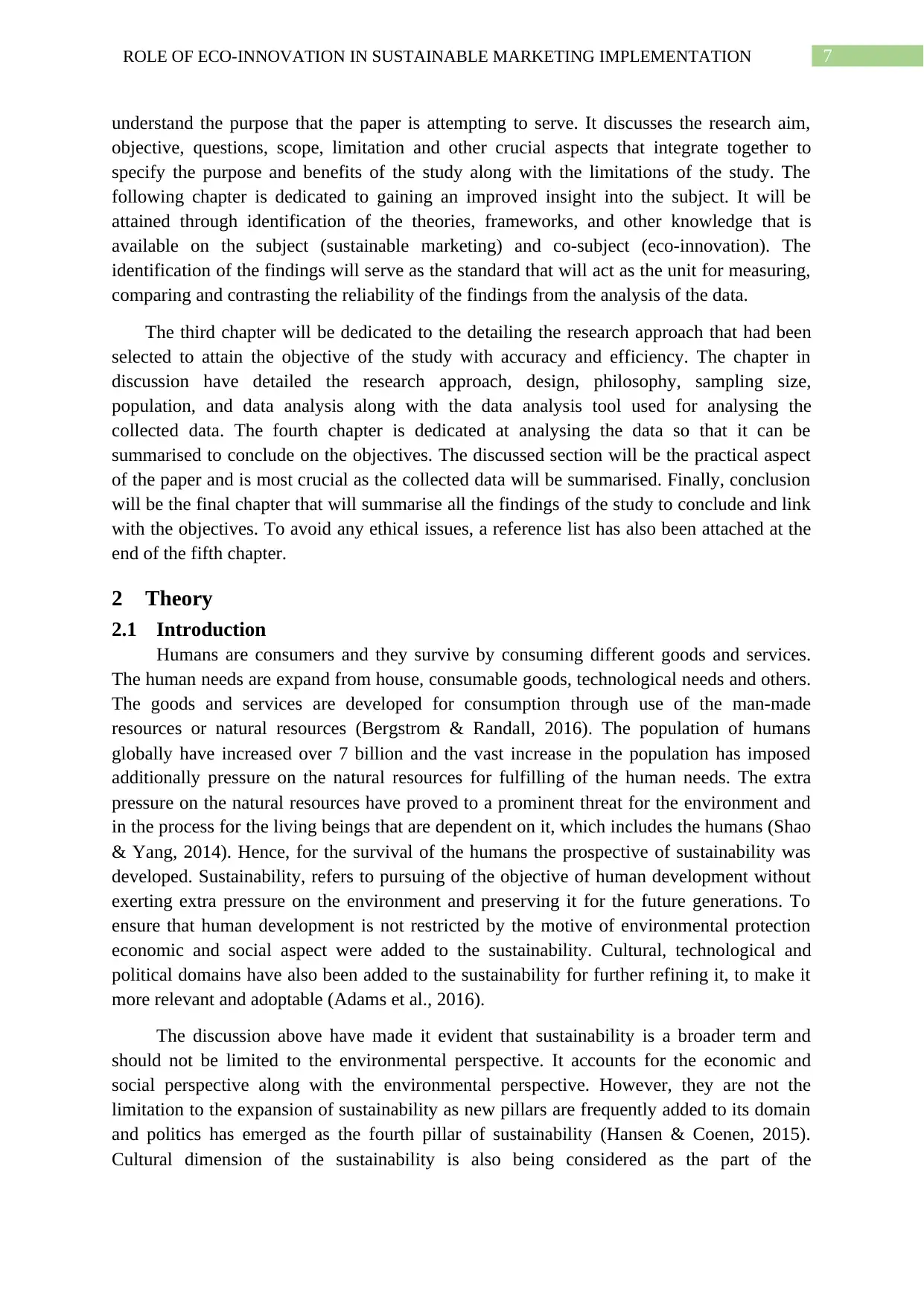
7ROLE OF ECO-INNOVATION IN SUSTAINABLE MARKETING IMPLEMENTATION
understand the purpose that the paper is attempting to serve. It discusses the research aim,
objective, questions, scope, limitation and other crucial aspects that integrate together to
specify the purpose and benefits of the study along with the limitations of the study. The
following chapter is dedicated to gaining an improved insight into the subject. It will be
attained through identification of the theories, frameworks, and other knowledge that is
available on the subject (sustainable marketing) and co-subject (eco-innovation). The
identification of the findings will serve as the standard that will act as the unit for measuring,
comparing and contrasting the reliability of the findings from the analysis of the data.
The third chapter will be dedicated to the detailing the research approach that had been
selected to attain the objective of the study with accuracy and efficiency. The chapter in
discussion have detailed the research approach, design, philosophy, sampling size,
population, and data analysis along with the data analysis tool used for analysing the
collected data. The fourth chapter is dedicated at analysing the data so that it can be
summarised to conclude on the objectives. The discussed section will be the practical aspect
of the paper and is most crucial as the collected data will be summarised. Finally, conclusion
will be the final chapter that will summarise all the findings of the study to conclude and link
with the objectives. To avoid any ethical issues, a reference list has also been attached at the
end of the fifth chapter.
2 Theory
2.1 Introduction
Humans are consumers and they survive by consuming different goods and services.
The human needs are expand from house, consumable goods, technological needs and others.
The goods and services are developed for consumption through use of the man-made
resources or natural resources (Bergstrom & Randall, 2016). The population of humans
globally have increased over 7 billion and the vast increase in the population has imposed
additionally pressure on the natural resources for fulfilling of the human needs. The extra
pressure on the natural resources have proved to a prominent threat for the environment and
in the process for the living beings that are dependent on it, which includes the humans (Shao
& Yang, 2014). Hence, for the survival of the humans the prospective of sustainability was
developed. Sustainability, refers to pursuing of the objective of human development without
exerting extra pressure on the environment and preserving it for the future generations. To
ensure that human development is not restricted by the motive of environmental protection
economic and social aspect were added to the sustainability. Cultural, technological and
political domains have also been added to the sustainability for further refining it, to make it
more relevant and adoptable (Adams et al., 2016).
The discussion above have made it evident that sustainability is a broader term and
should not be limited to the environmental perspective. It accounts for the economic and
social perspective along with the environmental perspective. However, they are not the
limitation to the expansion of sustainability as new pillars are frequently added to its domain
and politics has emerged as the fourth pillar of sustainability (Hansen & Coenen, 2015).
Cultural dimension of the sustainability is also being considered as the part of the
understand the purpose that the paper is attempting to serve. It discusses the research aim,
objective, questions, scope, limitation and other crucial aspects that integrate together to
specify the purpose and benefits of the study along with the limitations of the study. The
following chapter is dedicated to gaining an improved insight into the subject. It will be
attained through identification of the theories, frameworks, and other knowledge that is
available on the subject (sustainable marketing) and co-subject (eco-innovation). The
identification of the findings will serve as the standard that will act as the unit for measuring,
comparing and contrasting the reliability of the findings from the analysis of the data.
The third chapter will be dedicated to the detailing the research approach that had been
selected to attain the objective of the study with accuracy and efficiency. The chapter in
discussion have detailed the research approach, design, philosophy, sampling size,
population, and data analysis along with the data analysis tool used for analysing the
collected data. The fourth chapter is dedicated at analysing the data so that it can be
summarised to conclude on the objectives. The discussed section will be the practical aspect
of the paper and is most crucial as the collected data will be summarised. Finally, conclusion
will be the final chapter that will summarise all the findings of the study to conclude and link
with the objectives. To avoid any ethical issues, a reference list has also been attached at the
end of the fifth chapter.
2 Theory
2.1 Introduction
Humans are consumers and they survive by consuming different goods and services.
The human needs are expand from house, consumable goods, technological needs and others.
The goods and services are developed for consumption through use of the man-made
resources or natural resources (Bergstrom & Randall, 2016). The population of humans
globally have increased over 7 billion and the vast increase in the population has imposed
additionally pressure on the natural resources for fulfilling of the human needs. The extra
pressure on the natural resources have proved to a prominent threat for the environment and
in the process for the living beings that are dependent on it, which includes the humans (Shao
& Yang, 2014). Hence, for the survival of the humans the prospective of sustainability was
developed. Sustainability, refers to pursuing of the objective of human development without
exerting extra pressure on the environment and preserving it for the future generations. To
ensure that human development is not restricted by the motive of environmental protection
economic and social aspect were added to the sustainability. Cultural, technological and
political domains have also been added to the sustainability for further refining it, to make it
more relevant and adoptable (Adams et al., 2016).
The discussion above have made it evident that sustainability is a broader term and
should not be limited to the environmental perspective. It accounts for the economic and
social perspective along with the environmental perspective. However, they are not the
limitation to the expansion of sustainability as new pillars are frequently added to its domain
and politics has emerged as the fourth pillar of sustainability (Hansen & Coenen, 2015).
Cultural dimension of the sustainability is also being considered as the part of the
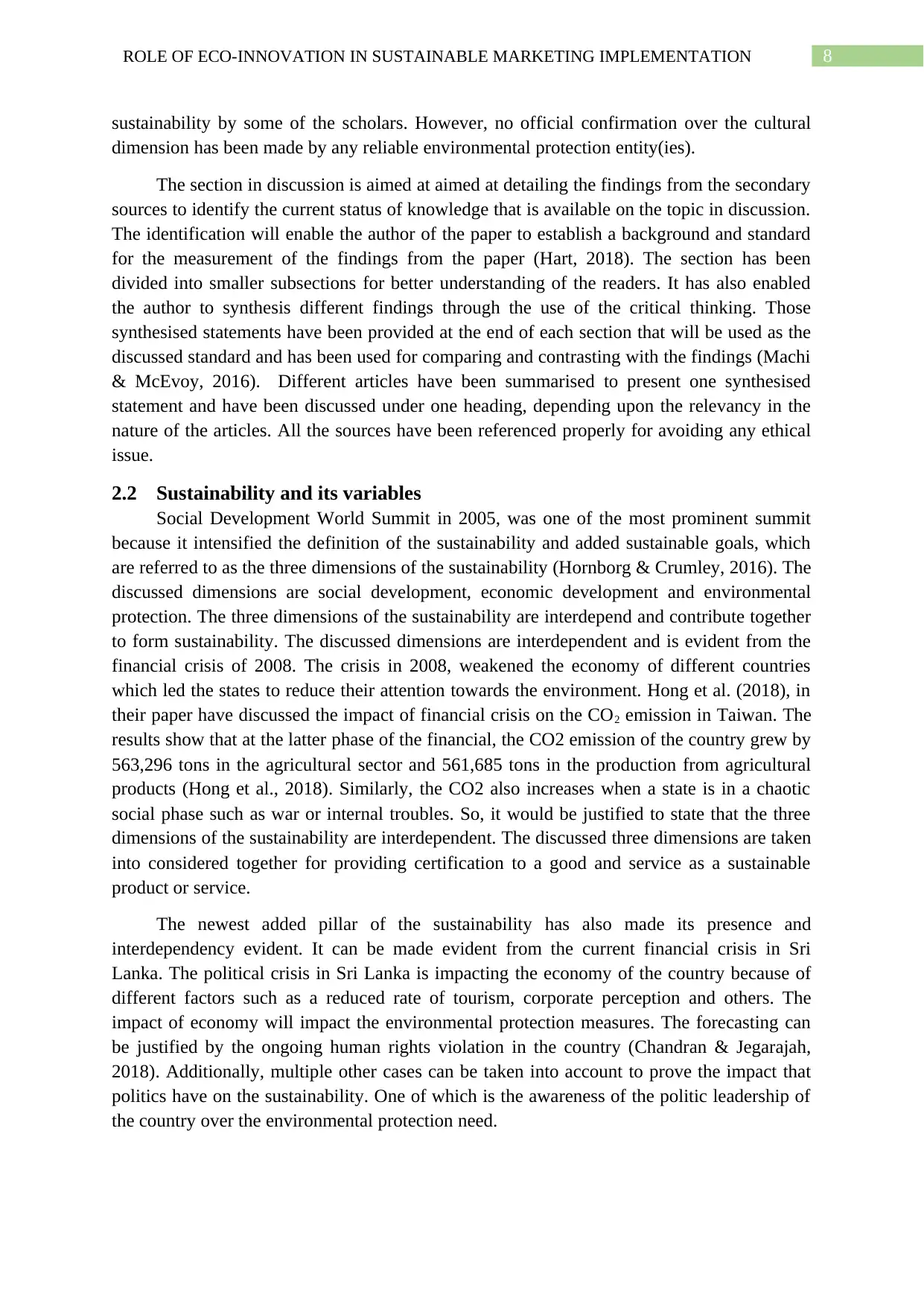
8ROLE OF ECO-INNOVATION IN SUSTAINABLE MARKETING IMPLEMENTATION
sustainability by some of the scholars. However, no official confirmation over the cultural
dimension has been made by any reliable environmental protection entity(ies).
The section in discussion is aimed at aimed at detailing the findings from the secondary
sources to identify the current status of knowledge that is available on the topic in discussion.
The identification will enable the author of the paper to establish a background and standard
for the measurement of the findings from the paper (Hart, 2018). The section has been
divided into smaller subsections for better understanding of the readers. It has also enabled
the author to synthesis different findings through the use of the critical thinking. Those
synthesised statements have been provided at the end of each section that will be used as the
discussed standard and has been used for comparing and contrasting with the findings (Machi
& McEvoy, 2016). Different articles have been summarised to present one synthesised
statement and have been discussed under one heading, depending upon the relevancy in the
nature of the articles. All the sources have been referenced properly for avoiding any ethical
issue.
2.2 Sustainability and its variables
Social Development World Summit in 2005, was one of the most prominent summit
because it intensified the definition of the sustainability and added sustainable goals, which
are referred to as the three dimensions of the sustainability (Hornborg & Crumley, 2016). The
discussed dimensions are social development, economic development and environmental
protection. The three dimensions of the sustainability are interdepend and contribute together
to form sustainability. The discussed dimensions are interdependent and is evident from the
financial crisis of 2008. The crisis in 2008, weakened the economy of different countries
which led the states to reduce their attention towards the environment. Hong et al. (2018), in
their paper have discussed the impact of financial crisis on the CO2 emission in Taiwan. The
results show that at the latter phase of the financial, the CO2 emission of the country grew by
563,296 tons in the agricultural sector and 561,685 tons in the production from agricultural
products (Hong et al., 2018). Similarly, the CO2 also increases when a state is in a chaotic
social phase such as war or internal troubles. So, it would be justified to state that the three
dimensions of the sustainability are interdependent. The discussed three dimensions are taken
into considered together for providing certification to a good and service as a sustainable
product or service.
The newest added pillar of the sustainability has also made its presence and
interdependency evident. It can be made evident from the current financial crisis in Sri
Lanka. The political crisis in Sri Lanka is impacting the economy of the country because of
different factors such as a reduced rate of tourism, corporate perception and others. The
impact of economy will impact the environmental protection measures. The forecasting can
be justified by the ongoing human rights violation in the country (Chandran & Jegarajah,
2018). Additionally, multiple other cases can be taken into account to prove the impact that
politics have on the sustainability. One of which is the awareness of the politic leadership of
the country over the environmental protection need.
sustainability by some of the scholars. However, no official confirmation over the cultural
dimension has been made by any reliable environmental protection entity(ies).
The section in discussion is aimed at aimed at detailing the findings from the secondary
sources to identify the current status of knowledge that is available on the topic in discussion.
The identification will enable the author of the paper to establish a background and standard
for the measurement of the findings from the paper (Hart, 2018). The section has been
divided into smaller subsections for better understanding of the readers. It has also enabled
the author to synthesis different findings through the use of the critical thinking. Those
synthesised statements have been provided at the end of each section that will be used as the
discussed standard and has been used for comparing and contrasting with the findings (Machi
& McEvoy, 2016). Different articles have been summarised to present one synthesised
statement and have been discussed under one heading, depending upon the relevancy in the
nature of the articles. All the sources have been referenced properly for avoiding any ethical
issue.
2.2 Sustainability and its variables
Social Development World Summit in 2005, was one of the most prominent summit
because it intensified the definition of the sustainability and added sustainable goals, which
are referred to as the three dimensions of the sustainability (Hornborg & Crumley, 2016). The
discussed dimensions are social development, economic development and environmental
protection. The three dimensions of the sustainability are interdepend and contribute together
to form sustainability. The discussed dimensions are interdependent and is evident from the
financial crisis of 2008. The crisis in 2008, weakened the economy of different countries
which led the states to reduce their attention towards the environment. Hong et al. (2018), in
their paper have discussed the impact of financial crisis on the CO2 emission in Taiwan. The
results show that at the latter phase of the financial, the CO2 emission of the country grew by
563,296 tons in the agricultural sector and 561,685 tons in the production from agricultural
products (Hong et al., 2018). Similarly, the CO2 also increases when a state is in a chaotic
social phase such as war or internal troubles. So, it would be justified to state that the three
dimensions of the sustainability are interdependent. The discussed three dimensions are taken
into considered together for providing certification to a good and service as a sustainable
product or service.
The newest added pillar of the sustainability has also made its presence and
interdependency evident. It can be made evident from the current financial crisis in Sri
Lanka. The political crisis in Sri Lanka is impacting the economy of the country because of
different factors such as a reduced rate of tourism, corporate perception and others. The
impact of economy will impact the environmental protection measures. The forecasting can
be justified by the ongoing human rights violation in the country (Chandran & Jegarajah,
2018). Additionally, multiple other cases can be taken into account to prove the impact that
politics have on the sustainability. One of which is the awareness of the politic leadership of
the country over the environmental protection need.
You're viewing a preview
Unlock full access by subscribing today!
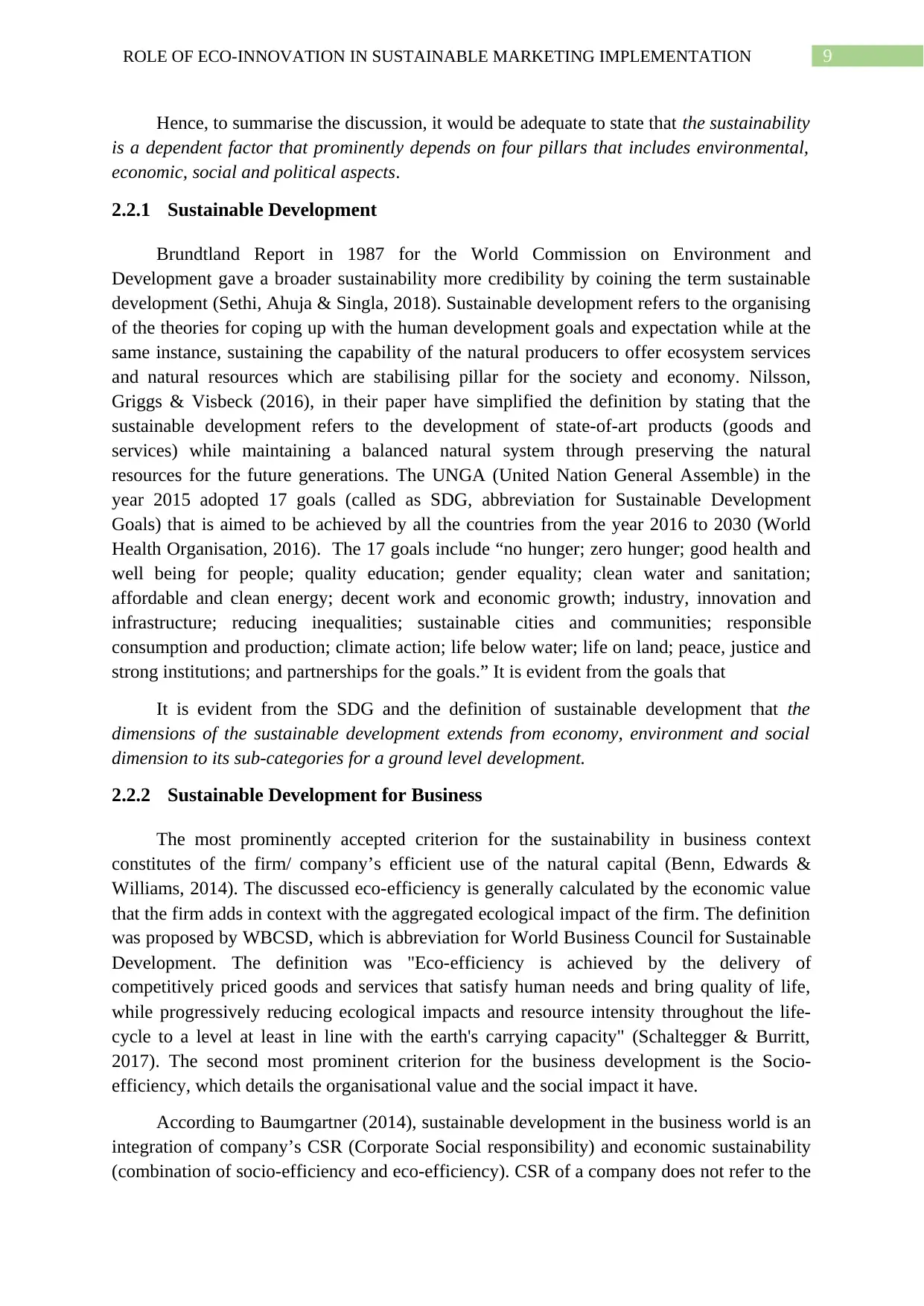
9ROLE OF ECO-INNOVATION IN SUSTAINABLE MARKETING IMPLEMENTATION
Hence, to summarise the discussion, it would be adequate to state that the sustainability
is a dependent factor that prominently depends on four pillars that includes environmental,
economic, social and political aspects.
2.2.1 Sustainable Development
Brundtland Report in 1987 for the World Commission on Environment and
Development gave a broader sustainability more credibility by coining the term sustainable
development (Sethi, Ahuja & Singla, 2018). Sustainable development refers to the organising
of the theories for coping up with the human development goals and expectation while at the
same instance, sustaining the capability of the natural producers to offer ecosystem services
and natural resources which are stabilising pillar for the society and economy. Nilsson,
Griggs & Visbeck (2016), in their paper have simplified the definition by stating that the
sustainable development refers to the development of state-of-art products (goods and
services) while maintaining a balanced natural system through preserving the natural
resources for the future generations. The UNGA (United Nation General Assemble) in the
year 2015 adopted 17 goals (called as SDG, abbreviation for Sustainable Development
Goals) that is aimed to be achieved by all the countries from the year 2016 to 2030 (World
Health Organisation, 2016). The 17 goals include “no hunger; zero hunger; good health and
well being for people; quality education; gender equality; clean water and sanitation;
affordable and clean energy; decent work and economic growth; industry, innovation and
infrastructure; reducing inequalities; sustainable cities and communities; responsible
consumption and production; climate action; life below water; life on land; peace, justice and
strong institutions; and partnerships for the goals.” It is evident from the goals that
It is evident from the SDG and the definition of sustainable development that the
dimensions of the sustainable development extends from economy, environment and social
dimension to its sub-categories for a ground level development.
2.2.2 Sustainable Development for Business
The most prominently accepted criterion for the sustainability in business context
constitutes of the firm/ company’s efficient use of the natural capital (Benn, Edwards &
Williams, 2014). The discussed eco-efficiency is generally calculated by the economic value
that the firm adds in context with the aggregated ecological impact of the firm. The definition
was proposed by WBCSD, which is abbreviation for World Business Council for Sustainable
Development. The definition was "Eco-efficiency is achieved by the delivery of
competitively priced goods and services that satisfy human needs and bring quality of life,
while progressively reducing ecological impacts and resource intensity throughout the life-
cycle to a level at least in line with the earth's carrying capacity" (Schaltegger & Burritt,
2017). The second most prominent criterion for the business development is the Socio-
efficiency, which details the organisational value and the social impact it have.
According to Baumgartner (2014), sustainable development in the business world is an
integration of company’s CSR (Corporate Social responsibility) and economic sustainability
(combination of socio-efficiency and eco-efficiency). CSR of a company does not refer to the
Hence, to summarise the discussion, it would be adequate to state that the sustainability
is a dependent factor that prominently depends on four pillars that includes environmental,
economic, social and political aspects.
2.2.1 Sustainable Development
Brundtland Report in 1987 for the World Commission on Environment and
Development gave a broader sustainability more credibility by coining the term sustainable
development (Sethi, Ahuja & Singla, 2018). Sustainable development refers to the organising
of the theories for coping up with the human development goals and expectation while at the
same instance, sustaining the capability of the natural producers to offer ecosystem services
and natural resources which are stabilising pillar for the society and economy. Nilsson,
Griggs & Visbeck (2016), in their paper have simplified the definition by stating that the
sustainable development refers to the development of state-of-art products (goods and
services) while maintaining a balanced natural system through preserving the natural
resources for the future generations. The UNGA (United Nation General Assemble) in the
year 2015 adopted 17 goals (called as SDG, abbreviation for Sustainable Development
Goals) that is aimed to be achieved by all the countries from the year 2016 to 2030 (World
Health Organisation, 2016). The 17 goals include “no hunger; zero hunger; good health and
well being for people; quality education; gender equality; clean water and sanitation;
affordable and clean energy; decent work and economic growth; industry, innovation and
infrastructure; reducing inequalities; sustainable cities and communities; responsible
consumption and production; climate action; life below water; life on land; peace, justice and
strong institutions; and partnerships for the goals.” It is evident from the goals that
It is evident from the SDG and the definition of sustainable development that the
dimensions of the sustainable development extends from economy, environment and social
dimension to its sub-categories for a ground level development.
2.2.2 Sustainable Development for Business
The most prominently accepted criterion for the sustainability in business context
constitutes of the firm/ company’s efficient use of the natural capital (Benn, Edwards &
Williams, 2014). The discussed eco-efficiency is generally calculated by the economic value
that the firm adds in context with the aggregated ecological impact of the firm. The definition
was proposed by WBCSD, which is abbreviation for World Business Council for Sustainable
Development. The definition was "Eco-efficiency is achieved by the delivery of
competitively priced goods and services that satisfy human needs and bring quality of life,
while progressively reducing ecological impacts and resource intensity throughout the life-
cycle to a level at least in line with the earth's carrying capacity" (Schaltegger & Burritt,
2017). The second most prominent criterion for the business development is the Socio-
efficiency, which details the organisational value and the social impact it have.
According to Baumgartner (2014), sustainable development in the business world is an
integration of company’s CSR (Corporate Social responsibility) and economic sustainability
(combination of socio-efficiency and eco-efficiency). CSR of a company does not refer to the
Paraphrase This Document
Need a fresh take? Get an instant paraphrase of this document with our AI Paraphraser
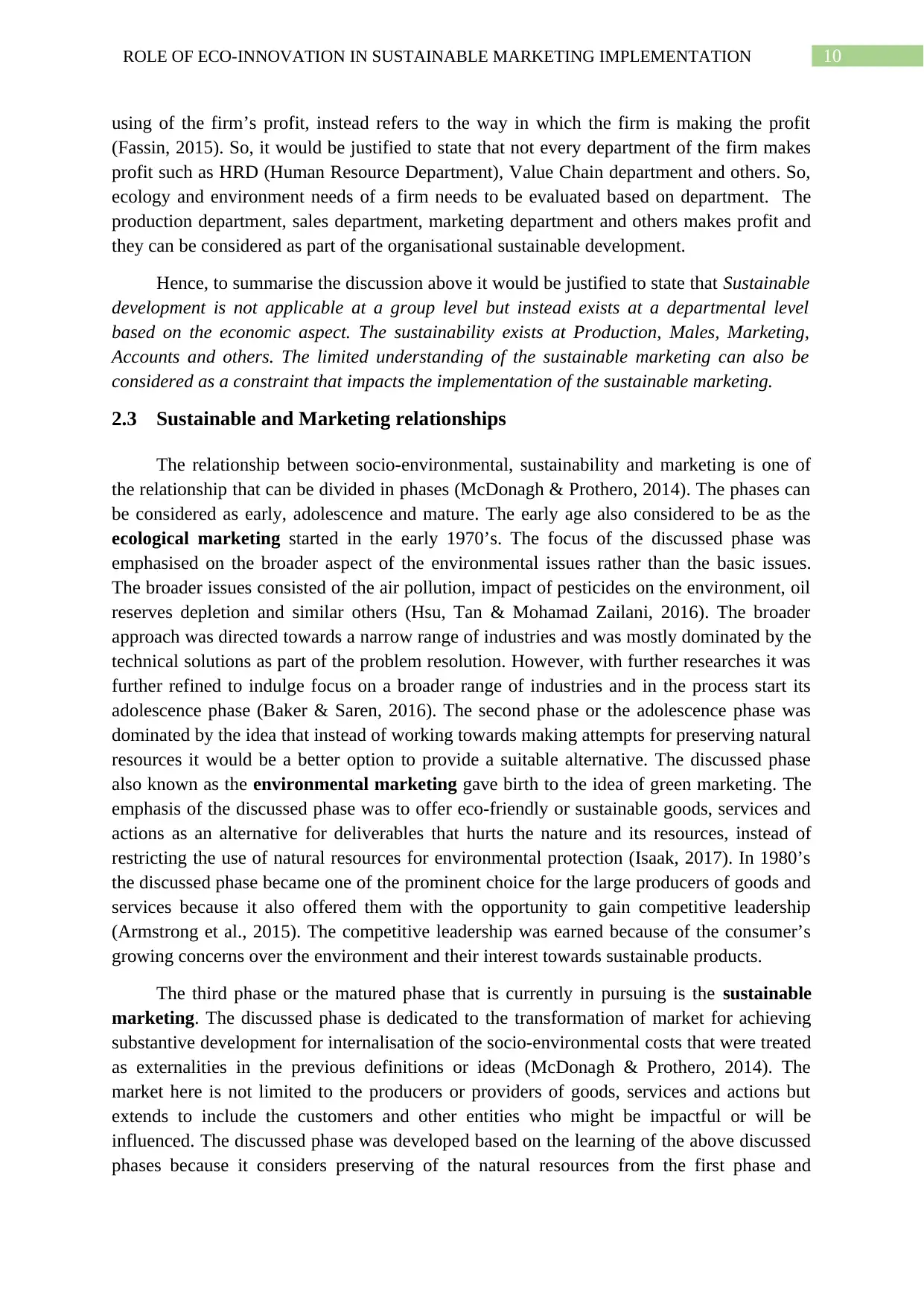
10ROLE OF ECO-INNOVATION IN SUSTAINABLE MARKETING IMPLEMENTATION
using of the firm’s profit, instead refers to the way in which the firm is making the profit
(Fassin, 2015). So, it would be justified to state that not every department of the firm makes
profit such as HRD (Human Resource Department), Value Chain department and others. So,
ecology and environment needs of a firm needs to be evaluated based on department. The
production department, sales department, marketing department and others makes profit and
they can be considered as part of the organisational sustainable development.
Hence, to summarise the discussion above it would be justified to state that Sustainable
development is not applicable at a group level but instead exists at a departmental level
based on the economic aspect. The sustainability exists at Production, Males, Marketing,
Accounts and others. The limited understanding of the sustainable marketing can also be
considered as a constraint that impacts the implementation of the sustainable marketing.
2.3 Sustainable and Marketing relationships
The relationship between socio-environmental, sustainability and marketing is one of
the relationship that can be divided in phases (McDonagh & Prothero, 2014). The phases can
be considered as early, adolescence and mature. The early age also considered to be as the
ecological marketing started in the early 1970’s. The focus of the discussed phase was
emphasised on the broader aspect of the environmental issues rather than the basic issues.
The broader issues consisted of the air pollution, impact of pesticides on the environment, oil
reserves depletion and similar others (Hsu, Tan & Mohamad Zailani, 2016). The broader
approach was directed towards a narrow range of industries and was mostly dominated by the
technical solutions as part of the problem resolution. However, with further researches it was
further refined to indulge focus on a broader range of industries and in the process start its
adolescence phase (Baker & Saren, 2016). The second phase or the adolescence phase was
dominated by the idea that instead of working towards making attempts for preserving natural
resources it would be a better option to provide a suitable alternative. The discussed phase
also known as the environmental marketing gave birth to the idea of green marketing. The
emphasis of the discussed phase was to offer eco-friendly or sustainable goods, services and
actions as an alternative for deliverables that hurts the nature and its resources, instead of
restricting the use of natural resources for environmental protection (Isaak, 2017). In 1980’s
the discussed phase became one of the prominent choice for the large producers of goods and
services because it also offered them with the opportunity to gain competitive leadership
(Armstrong et al., 2015). The competitive leadership was earned because of the consumer’s
growing concerns over the environment and their interest towards sustainable products.
The third phase or the matured phase that is currently in pursuing is the sustainable
marketing. The discussed phase is dedicated to the transformation of market for achieving
substantive development for internalisation of the socio-environmental costs that were treated
as externalities in the previous definitions or ideas (McDonagh & Prothero, 2014). The
market here is not limited to the producers or providers of goods, services and actions but
extends to include the customers and other entities who might be impactful or will be
influenced. The discussed phase was developed based on the learning of the above discussed
phases because it considers preserving of the natural resources from the first phase and
using of the firm’s profit, instead refers to the way in which the firm is making the profit
(Fassin, 2015). So, it would be justified to state that not every department of the firm makes
profit such as HRD (Human Resource Department), Value Chain department and others. So,
ecology and environment needs of a firm needs to be evaluated based on department. The
production department, sales department, marketing department and others makes profit and
they can be considered as part of the organisational sustainable development.
Hence, to summarise the discussion above it would be justified to state that Sustainable
development is not applicable at a group level but instead exists at a departmental level
based on the economic aspect. The sustainability exists at Production, Males, Marketing,
Accounts and others. The limited understanding of the sustainable marketing can also be
considered as a constraint that impacts the implementation of the sustainable marketing.
2.3 Sustainable and Marketing relationships
The relationship between socio-environmental, sustainability and marketing is one of
the relationship that can be divided in phases (McDonagh & Prothero, 2014). The phases can
be considered as early, adolescence and mature. The early age also considered to be as the
ecological marketing started in the early 1970’s. The focus of the discussed phase was
emphasised on the broader aspect of the environmental issues rather than the basic issues.
The broader issues consisted of the air pollution, impact of pesticides on the environment, oil
reserves depletion and similar others (Hsu, Tan & Mohamad Zailani, 2016). The broader
approach was directed towards a narrow range of industries and was mostly dominated by the
technical solutions as part of the problem resolution. However, with further researches it was
further refined to indulge focus on a broader range of industries and in the process start its
adolescence phase (Baker & Saren, 2016). The second phase or the adolescence phase was
dominated by the idea that instead of working towards making attempts for preserving natural
resources it would be a better option to provide a suitable alternative. The discussed phase
also known as the environmental marketing gave birth to the idea of green marketing. The
emphasis of the discussed phase was to offer eco-friendly or sustainable goods, services and
actions as an alternative for deliverables that hurts the nature and its resources, instead of
restricting the use of natural resources for environmental protection (Isaak, 2017). In 1980’s
the discussed phase became one of the prominent choice for the large producers of goods and
services because it also offered them with the opportunity to gain competitive leadership
(Armstrong et al., 2015). The competitive leadership was earned because of the consumer’s
growing concerns over the environment and their interest towards sustainable products.
The third phase or the matured phase that is currently in pursuing is the sustainable
marketing. The discussed phase is dedicated to the transformation of market for achieving
substantive development for internalisation of the socio-environmental costs that were treated
as externalities in the previous definitions or ideas (McDonagh & Prothero, 2014). The
market here is not limited to the producers or providers of goods, services and actions but
extends to include the customers and other entities who might be impactful or will be
influenced. The discussed phase was developed based on the learning of the above discussed
phases because it considers preserving of the natural resources from the first phase and
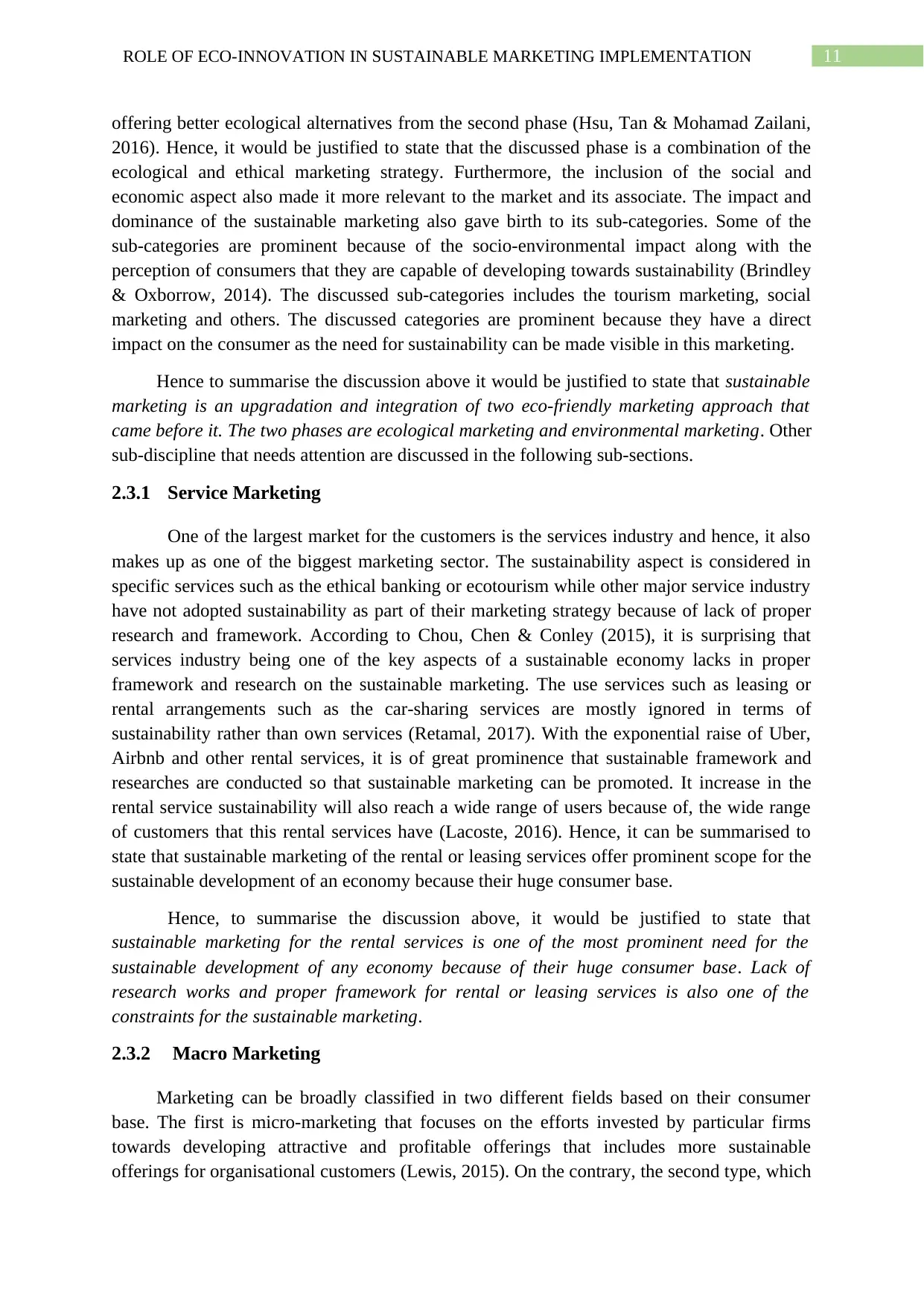
11ROLE OF ECO-INNOVATION IN SUSTAINABLE MARKETING IMPLEMENTATION
offering better ecological alternatives from the second phase (Hsu, Tan & Mohamad Zailani,
2016). Hence, it would be justified to state that the discussed phase is a combination of the
ecological and ethical marketing strategy. Furthermore, the inclusion of the social and
economic aspect also made it more relevant to the market and its associate. The impact and
dominance of the sustainable marketing also gave birth to its sub-categories. Some of the
sub-categories are prominent because of the socio-environmental impact along with the
perception of consumers that they are capable of developing towards sustainability (Brindley
& Oxborrow, 2014). The discussed sub-categories includes the tourism marketing, social
marketing and others. The discussed categories are prominent because they have a direct
impact on the consumer as the need for sustainability can be made visible in this marketing.
Hence to summarise the discussion above it would be justified to state that sustainable
marketing is an upgradation and integration of two eco-friendly marketing approach that
came before it. The two phases are ecological marketing and environmental marketing. Other
sub-discipline that needs attention are discussed in the following sub-sections.
2.3.1 Service Marketing
One of the largest market for the customers is the services industry and hence, it also
makes up as one of the biggest marketing sector. The sustainability aspect is considered in
specific services such as the ethical banking or ecotourism while other major service industry
have not adopted sustainability as part of their marketing strategy because of lack of proper
research and framework. According to Chou, Chen & Conley (2015), it is surprising that
services industry being one of the key aspects of a sustainable economy lacks in proper
framework and research on the sustainable marketing. The use services such as leasing or
rental arrangements such as the car-sharing services are mostly ignored in terms of
sustainability rather than own services (Retamal, 2017). With the exponential raise of Uber,
Airbnb and other rental services, it is of great prominence that sustainable framework and
researches are conducted so that sustainable marketing can be promoted. It increase in the
rental service sustainability will also reach a wide range of users because of, the wide range
of customers that this rental services have (Lacoste, 2016). Hence, it can be summarised to
state that sustainable marketing of the rental or leasing services offer prominent scope for the
sustainable development of an economy because their huge consumer base.
Hence, to summarise the discussion above, it would be justified to state that
sustainable marketing for the rental services is one of the most prominent need for the
sustainable development of any economy because of their huge consumer base. Lack of
research works and proper framework for rental or leasing services is also one of the
constraints for the sustainable marketing.
2.3.2 Macro Marketing
Marketing can be broadly classified in two different fields based on their consumer
base. The first is micro-marketing that focuses on the efforts invested by particular firms
towards developing attractive and profitable offerings that includes more sustainable
offerings for organisational customers (Lewis, 2015). On the contrary, the second type, which
offering better ecological alternatives from the second phase (Hsu, Tan & Mohamad Zailani,
2016). Hence, it would be justified to state that the discussed phase is a combination of the
ecological and ethical marketing strategy. Furthermore, the inclusion of the social and
economic aspect also made it more relevant to the market and its associate. The impact and
dominance of the sustainable marketing also gave birth to its sub-categories. Some of the
sub-categories are prominent because of the socio-environmental impact along with the
perception of consumers that they are capable of developing towards sustainability (Brindley
& Oxborrow, 2014). The discussed sub-categories includes the tourism marketing, social
marketing and others. The discussed categories are prominent because they have a direct
impact on the consumer as the need for sustainability can be made visible in this marketing.
Hence to summarise the discussion above it would be justified to state that sustainable
marketing is an upgradation and integration of two eco-friendly marketing approach that
came before it. The two phases are ecological marketing and environmental marketing. Other
sub-discipline that needs attention are discussed in the following sub-sections.
2.3.1 Service Marketing
One of the largest market for the customers is the services industry and hence, it also
makes up as one of the biggest marketing sector. The sustainability aspect is considered in
specific services such as the ethical banking or ecotourism while other major service industry
have not adopted sustainability as part of their marketing strategy because of lack of proper
research and framework. According to Chou, Chen & Conley (2015), it is surprising that
services industry being one of the key aspects of a sustainable economy lacks in proper
framework and research on the sustainable marketing. The use services such as leasing or
rental arrangements such as the car-sharing services are mostly ignored in terms of
sustainability rather than own services (Retamal, 2017). With the exponential raise of Uber,
Airbnb and other rental services, it is of great prominence that sustainable framework and
researches are conducted so that sustainable marketing can be promoted. It increase in the
rental service sustainability will also reach a wide range of users because of, the wide range
of customers that this rental services have (Lacoste, 2016). Hence, it can be summarised to
state that sustainable marketing of the rental or leasing services offer prominent scope for the
sustainable development of an economy because their huge consumer base.
Hence, to summarise the discussion above, it would be justified to state that
sustainable marketing for the rental services is one of the most prominent need for the
sustainable development of any economy because of their huge consumer base. Lack of
research works and proper framework for rental or leasing services is also one of the
constraints for the sustainable marketing.
2.3.2 Macro Marketing
Marketing can be broadly classified in two different fields based on their consumer
base. The first is micro-marketing that focuses on the efforts invested by particular firms
towards developing attractive and profitable offerings that includes more sustainable
offerings for organisational customers (Lewis, 2015). On the contrary, the second type, which
You're viewing a preview
Unlock full access by subscribing today!
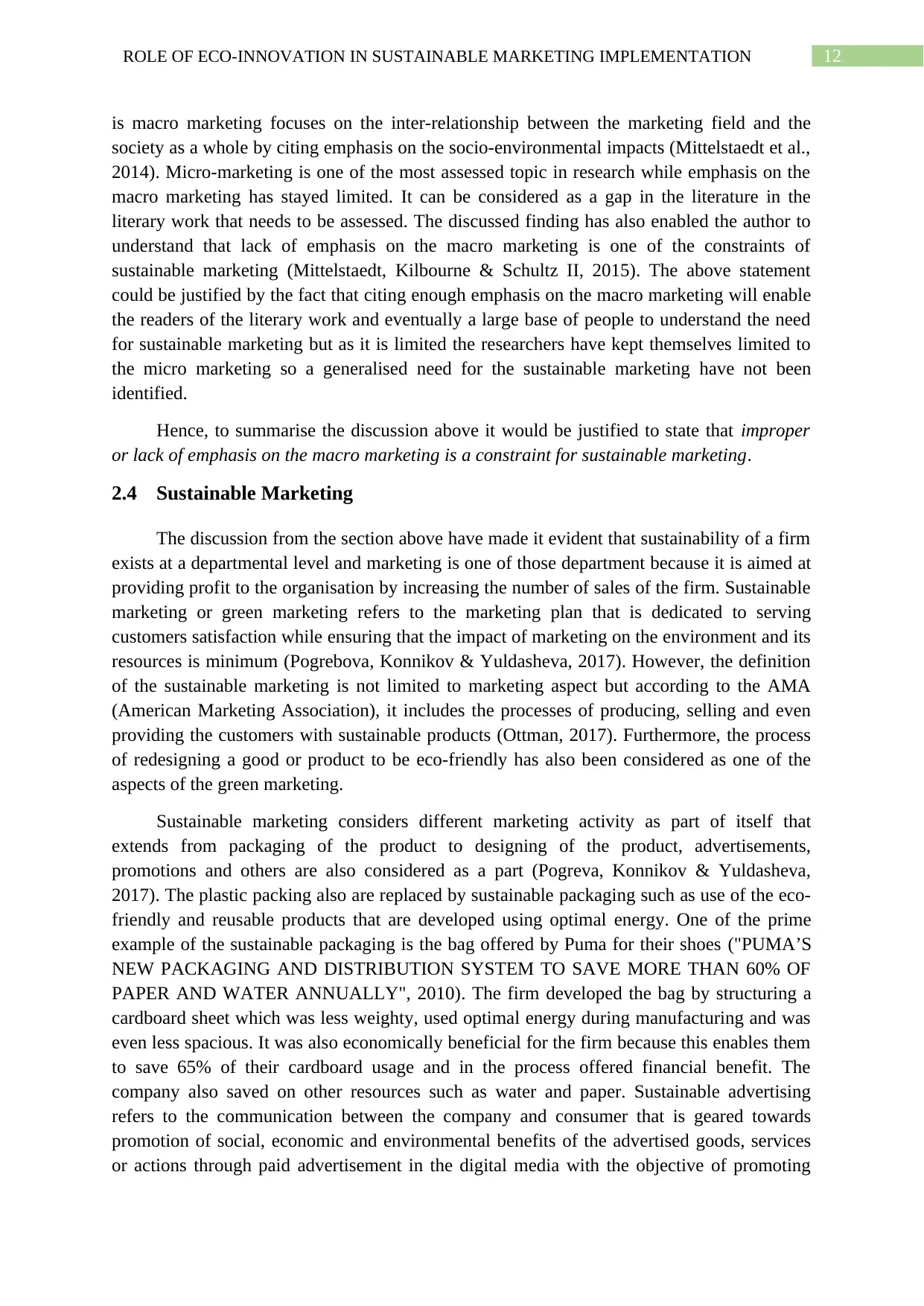
12ROLE OF ECO-INNOVATION IN SUSTAINABLE MARKETING IMPLEMENTATION
is macro marketing focuses on the inter-relationship between the marketing field and the
society as a whole by citing emphasis on the socio-environmental impacts (Mittelstaedt et al.,
2014). Micro-marketing is one of the most assessed topic in research while emphasis on the
macro marketing has stayed limited. It can be considered as a gap in the literature in the
literary work that needs to be assessed. The discussed finding has also enabled the author to
understand that lack of emphasis on the macro marketing is one of the constraints of
sustainable marketing (Mittelstaedt, Kilbourne & Schultz II, 2015). The above statement
could be justified by the fact that citing enough emphasis on the macro marketing will enable
the readers of the literary work and eventually a large base of people to understand the need
for sustainable marketing but as it is limited the researchers have kept themselves limited to
the micro marketing so a generalised need for the sustainable marketing have not been
identified.
Hence, to summarise the discussion above it would be justified to state that improper
or lack of emphasis on the macro marketing is a constraint for sustainable marketing.
2.4 Sustainable Marketing
The discussion from the section above have made it evident that sustainability of a firm
exists at a departmental level and marketing is one of those department because it is aimed at
providing profit to the organisation by increasing the number of sales of the firm. Sustainable
marketing or green marketing refers to the marketing plan that is dedicated to serving
customers satisfaction while ensuring that the impact of marketing on the environment and its
resources is minimum (Pogrebova, Konnikov & Yuldasheva, 2017). However, the definition
of the sustainable marketing is not limited to marketing aspect but according to the AMA
(American Marketing Association), it includes the processes of producing, selling and even
providing the customers with sustainable products (Ottman, 2017). Furthermore, the process
of redesigning a good or product to be eco-friendly has also been considered as one of the
aspects of the green marketing.
Sustainable marketing considers different marketing activity as part of itself that
extends from packaging of the product to designing of the product, advertisements,
promotions and others are also considered as a part (Pogreva, Konnikov & Yuldasheva,
2017). The plastic packing also are replaced by sustainable packaging such as use of the eco-
friendly and reusable products that are developed using optimal energy. One of the prime
example of the sustainable packaging is the bag offered by Puma for their shoes ("PUMA’S
NEW PACKAGING AND DISTRIBUTION SYSTEM TO SAVE MORE THAN 60% OF
PAPER AND WATER ANNUALLY", 2010). The firm developed the bag by structuring a
cardboard sheet which was less weighty, used optimal energy during manufacturing and was
even less spacious. It was also economically beneficial for the firm because this enables them
to save 65% of their cardboard usage and in the process offered financial benefit. The
company also saved on other resources such as water and paper. Sustainable advertising
refers to the communication between the company and consumer that is geared towards
promotion of social, economic and environmental benefits of the advertised goods, services
or actions through paid advertisement in the digital media with the objective of promoting
is macro marketing focuses on the inter-relationship between the marketing field and the
society as a whole by citing emphasis on the socio-environmental impacts (Mittelstaedt et al.,
2014). Micro-marketing is one of the most assessed topic in research while emphasis on the
macro marketing has stayed limited. It can be considered as a gap in the literature in the
literary work that needs to be assessed. The discussed finding has also enabled the author to
understand that lack of emphasis on the macro marketing is one of the constraints of
sustainable marketing (Mittelstaedt, Kilbourne & Schultz II, 2015). The above statement
could be justified by the fact that citing enough emphasis on the macro marketing will enable
the readers of the literary work and eventually a large base of people to understand the need
for sustainable marketing but as it is limited the researchers have kept themselves limited to
the micro marketing so a generalised need for the sustainable marketing have not been
identified.
Hence, to summarise the discussion above it would be justified to state that improper
or lack of emphasis on the macro marketing is a constraint for sustainable marketing.
2.4 Sustainable Marketing
The discussion from the section above have made it evident that sustainability of a firm
exists at a departmental level and marketing is one of those department because it is aimed at
providing profit to the organisation by increasing the number of sales of the firm. Sustainable
marketing or green marketing refers to the marketing plan that is dedicated to serving
customers satisfaction while ensuring that the impact of marketing on the environment and its
resources is minimum (Pogrebova, Konnikov & Yuldasheva, 2017). However, the definition
of the sustainable marketing is not limited to marketing aspect but according to the AMA
(American Marketing Association), it includes the processes of producing, selling and even
providing the customers with sustainable products (Ottman, 2017). Furthermore, the process
of redesigning a good or product to be eco-friendly has also been considered as one of the
aspects of the green marketing.
Sustainable marketing considers different marketing activity as part of itself that
extends from packaging of the product to designing of the product, advertisements,
promotions and others are also considered as a part (Pogreva, Konnikov & Yuldasheva,
2017). The plastic packing also are replaced by sustainable packaging such as use of the eco-
friendly and reusable products that are developed using optimal energy. One of the prime
example of the sustainable packaging is the bag offered by Puma for their shoes ("PUMA’S
NEW PACKAGING AND DISTRIBUTION SYSTEM TO SAVE MORE THAN 60% OF
PAPER AND WATER ANNUALLY", 2010). The firm developed the bag by structuring a
cardboard sheet which was less weighty, used optimal energy during manufacturing and was
even less spacious. It was also economically beneficial for the firm because this enables them
to save 65% of their cardboard usage and in the process offered financial benefit. The
company also saved on other resources such as water and paper. Sustainable advertising
refers to the communication between the company and consumer that is geared towards
promotion of social, economic and environmental benefits of the advertised goods, services
or actions through paid advertisement in the digital media with the objective of promoting
Paraphrase This Document
Need a fresh take? Get an instant paraphrase of this document with our AI Paraphraser
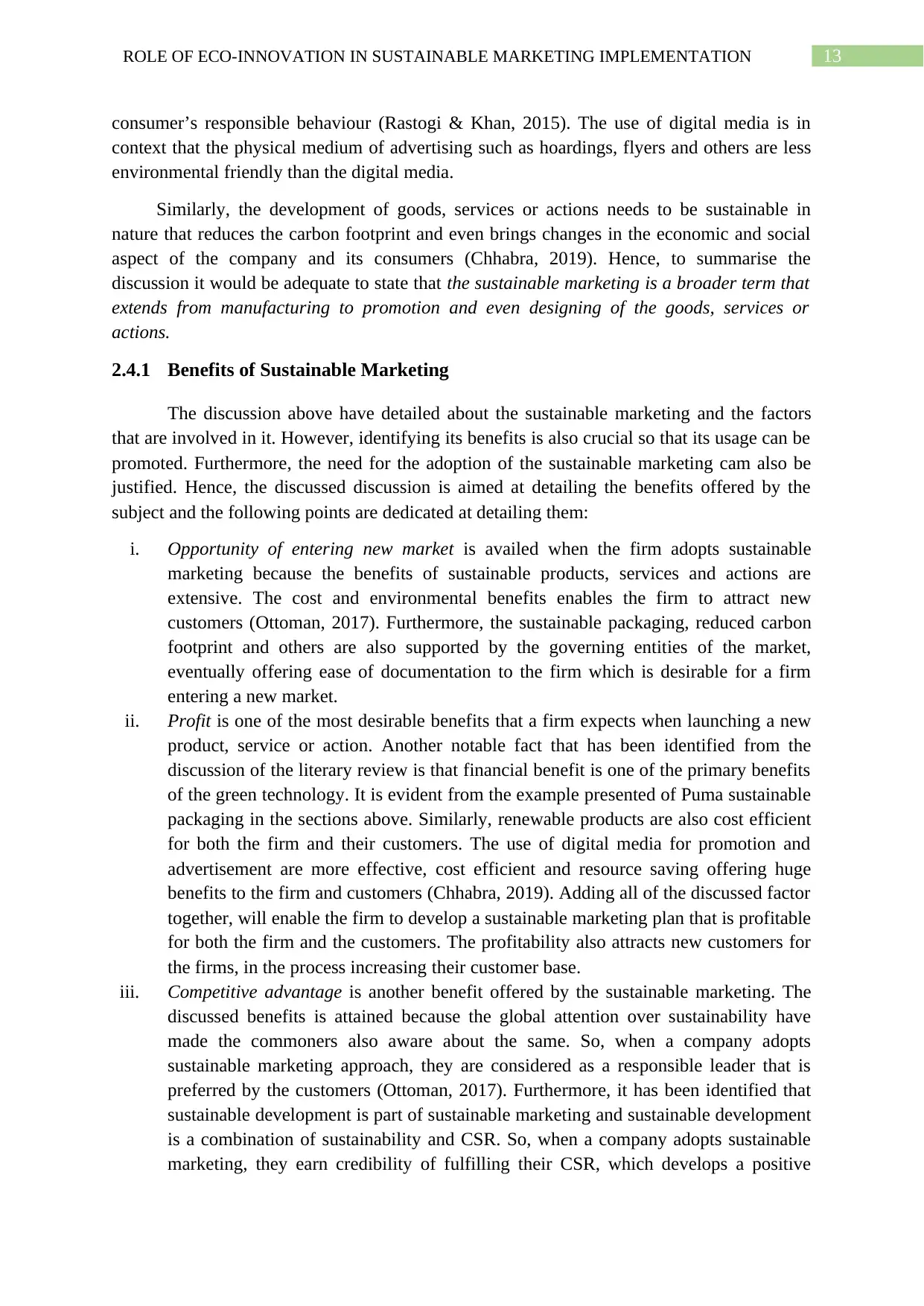
13ROLE OF ECO-INNOVATION IN SUSTAINABLE MARKETING IMPLEMENTATION
consumer’s responsible behaviour (Rastogi & Khan, 2015). The use of digital media is in
context that the physical medium of advertising such as hoardings, flyers and others are less
environmental friendly than the digital media.
Similarly, the development of goods, services or actions needs to be sustainable in
nature that reduces the carbon footprint and even brings changes in the economic and social
aspect of the company and its consumers (Chhabra, 2019). Hence, to summarise the
discussion it would be adequate to state that the sustainable marketing is a broader term that
extends from manufacturing to promotion and even designing of the goods, services or
actions.
2.4.1 Benefits of Sustainable Marketing
The discussion above have detailed about the sustainable marketing and the factors
that are involved in it. However, identifying its benefits is also crucial so that its usage can be
promoted. Furthermore, the need for the adoption of the sustainable marketing cam also be
justified. Hence, the discussed discussion is aimed at detailing the benefits offered by the
subject and the following points are dedicated at detailing them:
i. Opportunity of entering new market is availed when the firm adopts sustainable
marketing because the benefits of sustainable products, services and actions are
extensive. The cost and environmental benefits enables the firm to attract new
customers (Ottoman, 2017). Furthermore, the sustainable packaging, reduced carbon
footprint and others are also supported by the governing entities of the market,
eventually offering ease of documentation to the firm which is desirable for a firm
entering a new market.
ii. Profit is one of the most desirable benefits that a firm expects when launching a new
product, service or action. Another notable fact that has been identified from the
discussion of the literary review is that financial benefit is one of the primary benefits
of the green technology. It is evident from the example presented of Puma sustainable
packaging in the sections above. Similarly, renewable products are also cost efficient
for both the firm and their customers. The use of digital media for promotion and
advertisement are more effective, cost efficient and resource saving offering huge
benefits to the firm and customers (Chhabra, 2019). Adding all of the discussed factor
together, will enable the firm to develop a sustainable marketing plan that is profitable
for both the firm and the customers. The profitability also attracts new customers for
the firms, in the process increasing their customer base.
iii. Competitive advantage is another benefit offered by the sustainable marketing. The
discussed benefits is attained because the global attention over sustainability have
made the commoners also aware about the same. So, when a company adopts
sustainable marketing approach, they are considered as a responsible leader that is
preferred by the customers (Ottoman, 2017). Furthermore, it has been identified that
sustainable development is part of sustainable marketing and sustainable development
is a combination of sustainability and CSR. So, when a company adopts sustainable
marketing, they earn credibility of fulfilling their CSR, which develops a positive
consumer’s responsible behaviour (Rastogi & Khan, 2015). The use of digital media is in
context that the physical medium of advertising such as hoardings, flyers and others are less
environmental friendly than the digital media.
Similarly, the development of goods, services or actions needs to be sustainable in
nature that reduces the carbon footprint and even brings changes in the economic and social
aspect of the company and its consumers (Chhabra, 2019). Hence, to summarise the
discussion it would be adequate to state that the sustainable marketing is a broader term that
extends from manufacturing to promotion and even designing of the goods, services or
actions.
2.4.1 Benefits of Sustainable Marketing
The discussion above have detailed about the sustainable marketing and the factors
that are involved in it. However, identifying its benefits is also crucial so that its usage can be
promoted. Furthermore, the need for the adoption of the sustainable marketing cam also be
justified. Hence, the discussed discussion is aimed at detailing the benefits offered by the
subject and the following points are dedicated at detailing them:
i. Opportunity of entering new market is availed when the firm adopts sustainable
marketing because the benefits of sustainable products, services and actions are
extensive. The cost and environmental benefits enables the firm to attract new
customers (Ottoman, 2017). Furthermore, the sustainable packaging, reduced carbon
footprint and others are also supported by the governing entities of the market,
eventually offering ease of documentation to the firm which is desirable for a firm
entering a new market.
ii. Profit is one of the most desirable benefits that a firm expects when launching a new
product, service or action. Another notable fact that has been identified from the
discussion of the literary review is that financial benefit is one of the primary benefits
of the green technology. It is evident from the example presented of Puma sustainable
packaging in the sections above. Similarly, renewable products are also cost efficient
for both the firm and their customers. The use of digital media for promotion and
advertisement are more effective, cost efficient and resource saving offering huge
benefits to the firm and customers (Chhabra, 2019). Adding all of the discussed factor
together, will enable the firm to develop a sustainable marketing plan that is profitable
for both the firm and the customers. The profitability also attracts new customers for
the firms, in the process increasing their customer base.
iii. Competitive advantage is another benefit offered by the sustainable marketing. The
discussed benefits is attained because the global attention over sustainability have
made the commoners also aware about the same. So, when a company adopts
sustainable marketing approach, they are considered as a responsible leader that is
preferred by the customers (Ottoman, 2017). Furthermore, it has been identified that
sustainable development is part of sustainable marketing and sustainable development
is a combination of sustainability and CSR. So, when a company adopts sustainable
marketing, they earn credibility of fulfilling their CSR, which develops a positive
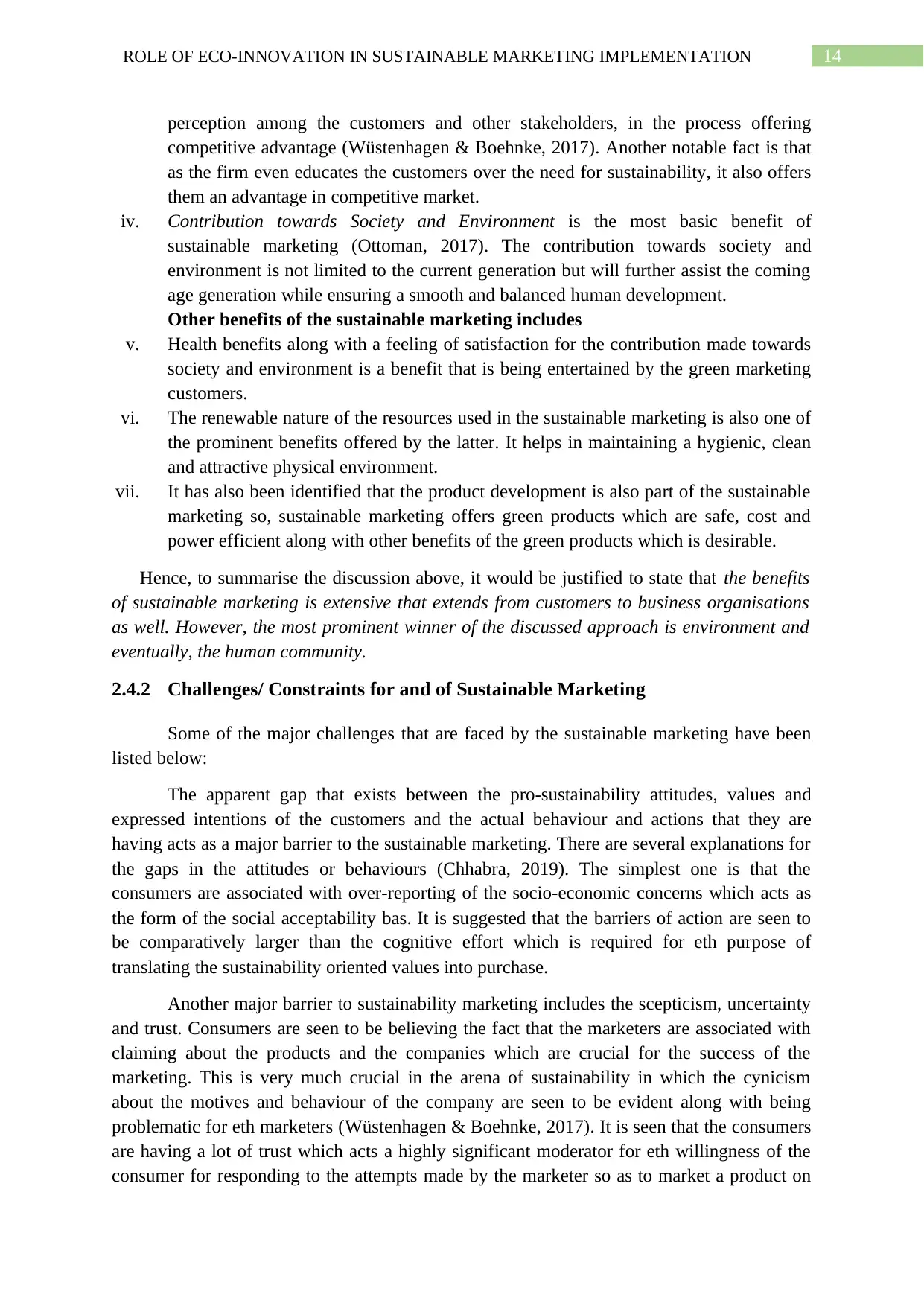
14ROLE OF ECO-INNOVATION IN SUSTAINABLE MARKETING IMPLEMENTATION
perception among the customers and other stakeholders, in the process offering
competitive advantage (Wüstenhagen & Boehnke, 2017). Another notable fact is that
as the firm even educates the customers over the need for sustainability, it also offers
them an advantage in competitive market.
iv. Contribution towards Society and Environment is the most basic benefit of
sustainable marketing (Ottoman, 2017). The contribution towards society and
environment is not limited to the current generation but will further assist the coming
age generation while ensuring a smooth and balanced human development.
Other benefits of the sustainable marketing includes
v. Health benefits along with a feeling of satisfaction for the contribution made towards
society and environment is a benefit that is being entertained by the green marketing
customers.
vi. The renewable nature of the resources used in the sustainable marketing is also one of
the prominent benefits offered by the latter. It helps in maintaining a hygienic, clean
and attractive physical environment.
vii. It has also been identified that the product development is also part of the sustainable
marketing so, sustainable marketing offers green products which are safe, cost and
power efficient along with other benefits of the green products which is desirable.
Hence, to summarise the discussion above, it would be justified to state that the benefits
of sustainable marketing is extensive that extends from customers to business organisations
as well. However, the most prominent winner of the discussed approach is environment and
eventually, the human community.
2.4.2 Challenges/ Constraints for and of Sustainable Marketing
Some of the major challenges that are faced by the sustainable marketing have been
listed below:
The apparent gap that exists between the pro-sustainability attitudes, values and
expressed intentions of the customers and the actual behaviour and actions that they are
having acts as a major barrier to the sustainable marketing. There are several explanations for
the gaps in the attitudes or behaviours (Chhabra, 2019). The simplest one is that the
consumers are associated with over-reporting of the socio-economic concerns which acts as
the form of the social acceptability bas. It is suggested that the barriers of action are seen to
be comparatively larger than the cognitive effort which is required for eth purpose of
translating the sustainability oriented values into purchase.
Another major barrier to sustainability marketing includes the scepticism, uncertainty
and trust. Consumers are seen to be believing the fact that the marketers are associated with
claiming about the products and the companies which are crucial for the success of the
marketing. This is very much crucial in the arena of sustainability in which the cynicism
about the motives and behaviour of the company are seen to be evident along with being
problematic for eth marketers (Wüstenhagen & Boehnke, 2017). It is seen that the consumers
are having a lot of trust which acts a highly significant moderator for eth willingness of the
consumer for responding to the attempts made by the marketer so as to market a product on
perception among the customers and other stakeholders, in the process offering
competitive advantage (Wüstenhagen & Boehnke, 2017). Another notable fact is that
as the firm even educates the customers over the need for sustainability, it also offers
them an advantage in competitive market.
iv. Contribution towards Society and Environment is the most basic benefit of
sustainable marketing (Ottoman, 2017). The contribution towards society and
environment is not limited to the current generation but will further assist the coming
age generation while ensuring a smooth and balanced human development.
Other benefits of the sustainable marketing includes
v. Health benefits along with a feeling of satisfaction for the contribution made towards
society and environment is a benefit that is being entertained by the green marketing
customers.
vi. The renewable nature of the resources used in the sustainable marketing is also one of
the prominent benefits offered by the latter. It helps in maintaining a hygienic, clean
and attractive physical environment.
vii. It has also been identified that the product development is also part of the sustainable
marketing so, sustainable marketing offers green products which are safe, cost and
power efficient along with other benefits of the green products which is desirable.
Hence, to summarise the discussion above, it would be justified to state that the benefits
of sustainable marketing is extensive that extends from customers to business organisations
as well. However, the most prominent winner of the discussed approach is environment and
eventually, the human community.
2.4.2 Challenges/ Constraints for and of Sustainable Marketing
Some of the major challenges that are faced by the sustainable marketing have been
listed below:
The apparent gap that exists between the pro-sustainability attitudes, values and
expressed intentions of the customers and the actual behaviour and actions that they are
having acts as a major barrier to the sustainable marketing. There are several explanations for
the gaps in the attitudes or behaviours (Chhabra, 2019). The simplest one is that the
consumers are associated with over-reporting of the socio-economic concerns which acts as
the form of the social acceptability bas. It is suggested that the barriers of action are seen to
be comparatively larger than the cognitive effort which is required for eth purpose of
translating the sustainability oriented values into purchase.
Another major barrier to sustainability marketing includes the scepticism, uncertainty
and trust. Consumers are seen to be believing the fact that the marketers are associated with
claiming about the products and the companies which are crucial for the success of the
marketing. This is very much crucial in the arena of sustainability in which the cynicism
about the motives and behaviour of the company are seen to be evident along with being
problematic for eth marketers (Wüstenhagen & Boehnke, 2017). It is seen that the consumers
are having a lot of trust which acts a highly significant moderator for eth willingness of the
consumer for responding to the attempts made by the marketer so as to market a product on
You're viewing a preview
Unlock full access by subscribing today!
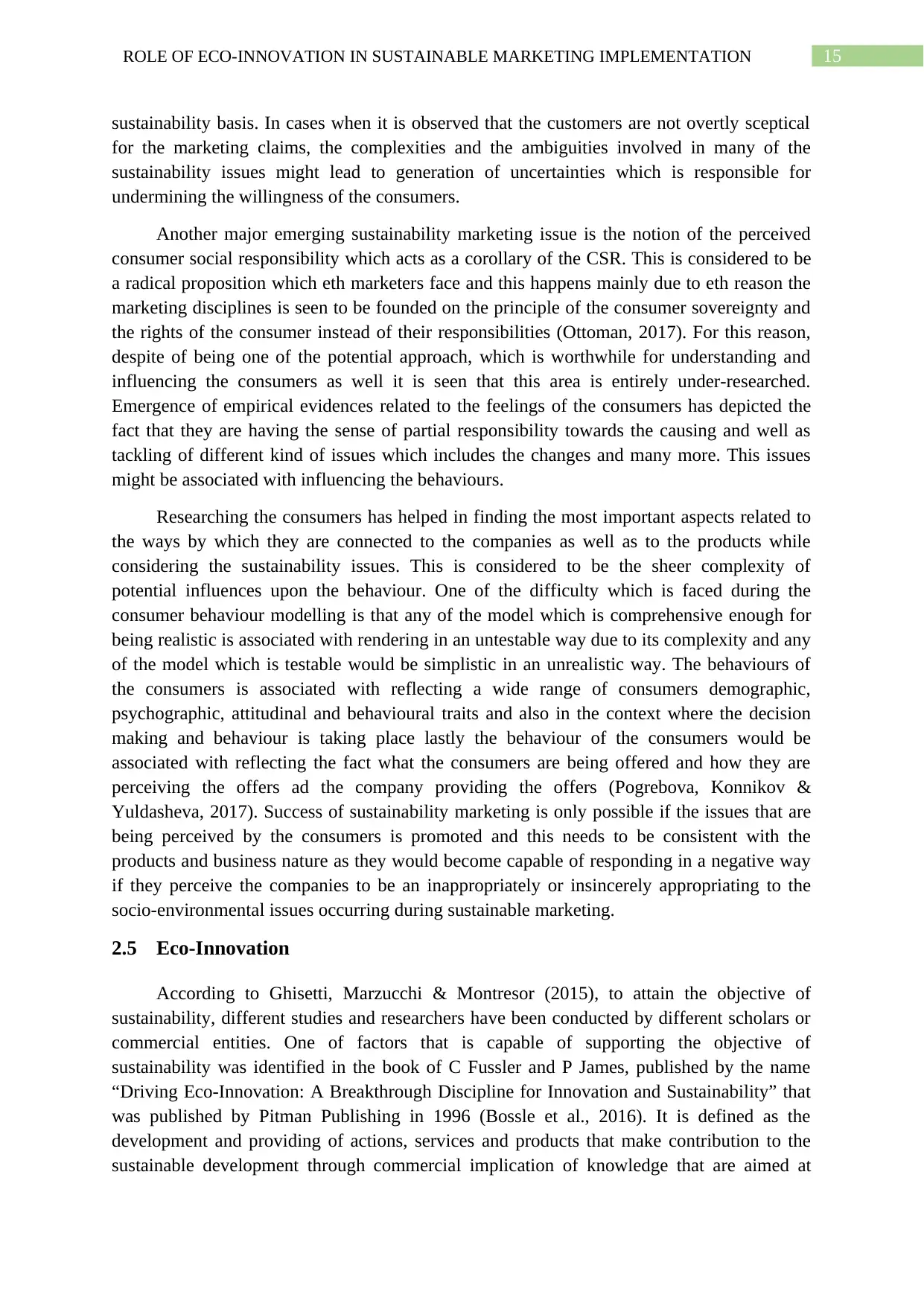
15ROLE OF ECO-INNOVATION IN SUSTAINABLE MARKETING IMPLEMENTATION
sustainability basis. In cases when it is observed that the customers are not overtly sceptical
for the marketing claims, the complexities and the ambiguities involved in many of the
sustainability issues might lead to generation of uncertainties which is responsible for
undermining the willingness of the consumers.
Another major emerging sustainability marketing issue is the notion of the perceived
consumer social responsibility which acts as a corollary of the CSR. This is considered to be
a radical proposition which eth marketers face and this happens mainly due to eth reason the
marketing disciplines is seen to be founded on the principle of the consumer sovereignty and
the rights of the consumer instead of their responsibilities (Ottoman, 2017). For this reason,
despite of being one of the potential approach, which is worthwhile for understanding and
influencing the consumers as well it is seen that this area is entirely under-researched.
Emergence of empirical evidences related to the feelings of the consumers has depicted the
fact that they are having the sense of partial responsibility towards the causing and well as
tackling of different kind of issues which includes the changes and many more. This issues
might be associated with influencing the behaviours.
Researching the consumers has helped in finding the most important aspects related to
the ways by which they are connected to the companies as well as to the products while
considering the sustainability issues. This is considered to be the sheer complexity of
potential influences upon the behaviour. One of the difficulty which is faced during the
consumer behaviour modelling is that any of the model which is comprehensive enough for
being realistic is associated with rendering in an untestable way due to its complexity and any
of the model which is testable would be simplistic in an unrealistic way. The behaviours of
the consumers is associated with reflecting a wide range of consumers demographic,
psychographic, attitudinal and behavioural traits and also in the context where the decision
making and behaviour is taking place lastly the behaviour of the consumers would be
associated with reflecting the fact what the consumers are being offered and how they are
perceiving the offers ad the company providing the offers (Pogrebova, Konnikov &
Yuldasheva, 2017). Success of sustainability marketing is only possible if the issues that are
being perceived by the consumers is promoted and this needs to be consistent with the
products and business nature as they would become capable of responding in a negative way
if they perceive the companies to be an inappropriately or insincerely appropriating to the
socio-environmental issues occurring during sustainable marketing.
2.5 Eco-Innovation
According to Ghisetti, Marzucchi & Montresor (2015), to attain the objective of
sustainability, different studies and researchers have been conducted by different scholars or
commercial entities. One of factors that is capable of supporting the objective of
sustainability was identified in the book of C Fussler and P James, published by the name
“Driving Eco-Innovation: A Breakthrough Discipline for Innovation and Sustainability” that
was published by Pitman Publishing in 1996 (Bossle et al., 2016). It is defined as the
development and providing of actions, services and products that make contribution to the
sustainable development through commercial implication of knowledge that are aimed at
sustainability basis. In cases when it is observed that the customers are not overtly sceptical
for the marketing claims, the complexities and the ambiguities involved in many of the
sustainability issues might lead to generation of uncertainties which is responsible for
undermining the willingness of the consumers.
Another major emerging sustainability marketing issue is the notion of the perceived
consumer social responsibility which acts as a corollary of the CSR. This is considered to be
a radical proposition which eth marketers face and this happens mainly due to eth reason the
marketing disciplines is seen to be founded on the principle of the consumer sovereignty and
the rights of the consumer instead of their responsibilities (Ottoman, 2017). For this reason,
despite of being one of the potential approach, which is worthwhile for understanding and
influencing the consumers as well it is seen that this area is entirely under-researched.
Emergence of empirical evidences related to the feelings of the consumers has depicted the
fact that they are having the sense of partial responsibility towards the causing and well as
tackling of different kind of issues which includes the changes and many more. This issues
might be associated with influencing the behaviours.
Researching the consumers has helped in finding the most important aspects related to
the ways by which they are connected to the companies as well as to the products while
considering the sustainability issues. This is considered to be the sheer complexity of
potential influences upon the behaviour. One of the difficulty which is faced during the
consumer behaviour modelling is that any of the model which is comprehensive enough for
being realistic is associated with rendering in an untestable way due to its complexity and any
of the model which is testable would be simplistic in an unrealistic way. The behaviours of
the consumers is associated with reflecting a wide range of consumers demographic,
psychographic, attitudinal and behavioural traits and also in the context where the decision
making and behaviour is taking place lastly the behaviour of the consumers would be
associated with reflecting the fact what the consumers are being offered and how they are
perceiving the offers ad the company providing the offers (Pogrebova, Konnikov &
Yuldasheva, 2017). Success of sustainability marketing is only possible if the issues that are
being perceived by the consumers is promoted and this needs to be consistent with the
products and business nature as they would become capable of responding in a negative way
if they perceive the companies to be an inappropriately or insincerely appropriating to the
socio-environmental issues occurring during sustainable marketing.
2.5 Eco-Innovation
According to Ghisetti, Marzucchi & Montresor (2015), to attain the objective of
sustainability, different studies and researchers have been conducted by different scholars or
commercial entities. One of factors that is capable of supporting the objective of
sustainability was identified in the book of C Fussler and P James, published by the name
“Driving Eco-Innovation: A Breakthrough Discipline for Innovation and Sustainability” that
was published by Pitman Publishing in 1996 (Bossle et al., 2016). It is defined as the
development and providing of actions, services and products that make contribution to the
sustainable development through commercial implication of knowledge that are aimed at
Paraphrase This Document
Need a fresh take? Get an instant paraphrase of this document with our AI Paraphraser
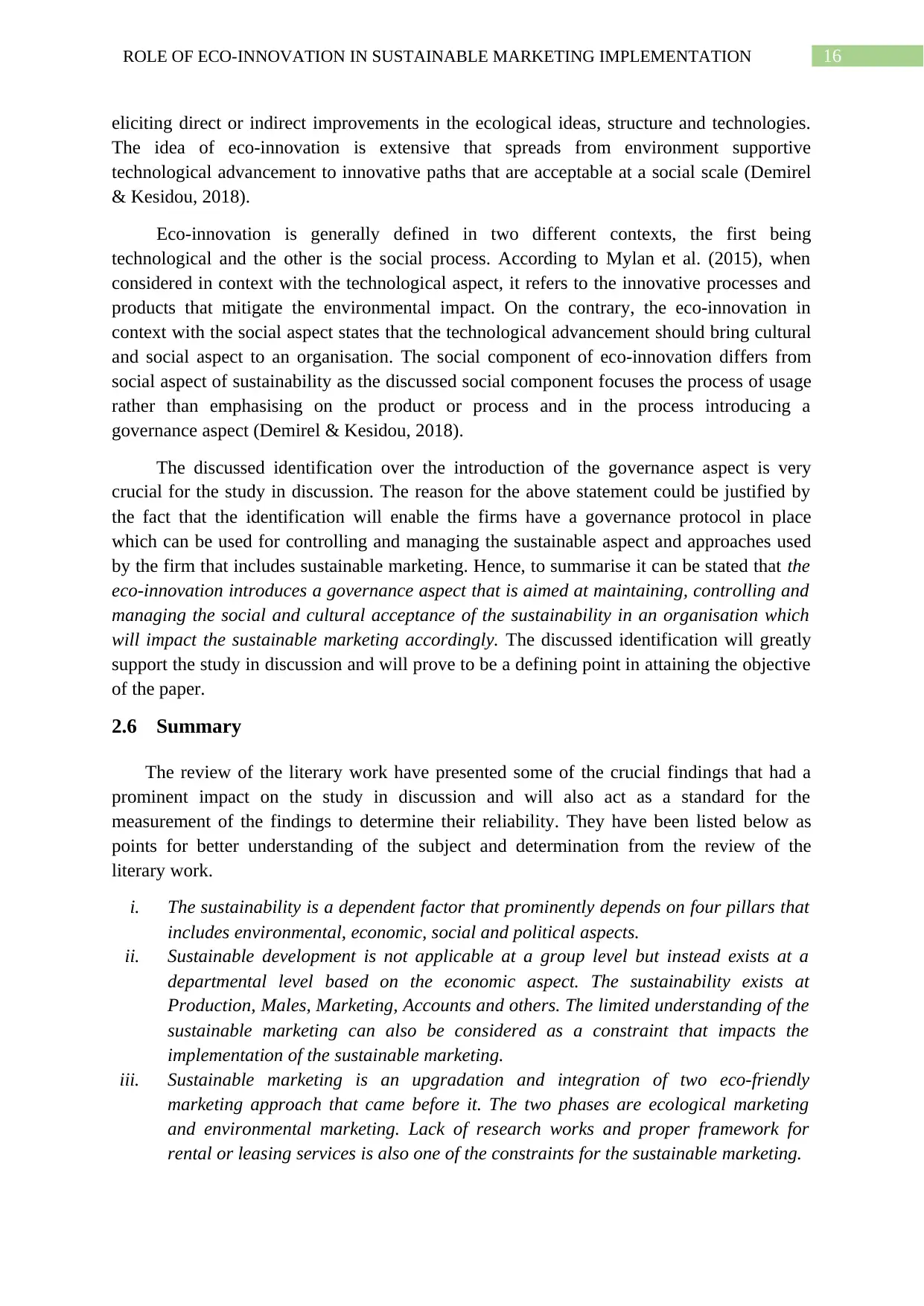
16ROLE OF ECO-INNOVATION IN SUSTAINABLE MARKETING IMPLEMENTATION
eliciting direct or indirect improvements in the ecological ideas, structure and technologies.
The idea of eco-innovation is extensive that spreads from environment supportive
technological advancement to innovative paths that are acceptable at a social scale (Demirel
& Kesidou, 2018).
Eco-innovation is generally defined in two different contexts, the first being
technological and the other is the social process. According to Mylan et al. (2015), when
considered in context with the technological aspect, it refers to the innovative processes and
products that mitigate the environmental impact. On the contrary, the eco-innovation in
context with the social aspect states that the technological advancement should bring cultural
and social aspect to an organisation. The social component of eco-innovation differs from
social aspect of sustainability as the discussed social component focuses the process of usage
rather than emphasising on the product or process and in the process introducing a
governance aspect (Demirel & Kesidou, 2018).
The discussed identification over the introduction of the governance aspect is very
crucial for the study in discussion. The reason for the above statement could be justified by
the fact that the identification will enable the firms have a governance protocol in place
which can be used for controlling and managing the sustainable aspect and approaches used
by the firm that includes sustainable marketing. Hence, to summarise it can be stated that the
eco-innovation introduces a governance aspect that is aimed at maintaining, controlling and
managing the social and cultural acceptance of the sustainability in an organisation which
will impact the sustainable marketing accordingly. The discussed identification will greatly
support the study in discussion and will prove to be a defining point in attaining the objective
of the paper.
2.6 Summary
The review of the literary work have presented some of the crucial findings that had a
prominent impact on the study in discussion and will also act as a standard for the
measurement of the findings to determine their reliability. They have been listed below as
points for better understanding of the subject and determination from the review of the
literary work.
i. The sustainability is a dependent factor that prominently depends on four pillars that
includes environmental, economic, social and political aspects.
ii. Sustainable development is not applicable at a group level but instead exists at a
departmental level based on the economic aspect. The sustainability exists at
Production, Males, Marketing, Accounts and others. The limited understanding of the
sustainable marketing can also be considered as a constraint that impacts the
implementation of the sustainable marketing.
iii. Sustainable marketing is an upgradation and integration of two eco-friendly
marketing approach that came before it. The two phases are ecological marketing
and environmental marketing. Lack of research works and proper framework for
rental or leasing services is also one of the constraints for the sustainable marketing.
eliciting direct or indirect improvements in the ecological ideas, structure and technologies.
The idea of eco-innovation is extensive that spreads from environment supportive
technological advancement to innovative paths that are acceptable at a social scale (Demirel
& Kesidou, 2018).
Eco-innovation is generally defined in two different contexts, the first being
technological and the other is the social process. According to Mylan et al. (2015), when
considered in context with the technological aspect, it refers to the innovative processes and
products that mitigate the environmental impact. On the contrary, the eco-innovation in
context with the social aspect states that the technological advancement should bring cultural
and social aspect to an organisation. The social component of eco-innovation differs from
social aspect of sustainability as the discussed social component focuses the process of usage
rather than emphasising on the product or process and in the process introducing a
governance aspect (Demirel & Kesidou, 2018).
The discussed identification over the introduction of the governance aspect is very
crucial for the study in discussion. The reason for the above statement could be justified by
the fact that the identification will enable the firms have a governance protocol in place
which can be used for controlling and managing the sustainable aspect and approaches used
by the firm that includes sustainable marketing. Hence, to summarise it can be stated that the
eco-innovation introduces a governance aspect that is aimed at maintaining, controlling and
managing the social and cultural acceptance of the sustainability in an organisation which
will impact the sustainable marketing accordingly. The discussed identification will greatly
support the study in discussion and will prove to be a defining point in attaining the objective
of the paper.
2.6 Summary
The review of the literary work have presented some of the crucial findings that had a
prominent impact on the study in discussion and will also act as a standard for the
measurement of the findings to determine their reliability. They have been listed below as
points for better understanding of the subject and determination from the review of the
literary work.
i. The sustainability is a dependent factor that prominently depends on four pillars that
includes environmental, economic, social and political aspects.
ii. Sustainable development is not applicable at a group level but instead exists at a
departmental level based on the economic aspect. The sustainability exists at
Production, Males, Marketing, Accounts and others. The limited understanding of the
sustainable marketing can also be considered as a constraint that impacts the
implementation of the sustainable marketing.
iii. Sustainable marketing is an upgradation and integration of two eco-friendly
marketing approach that came before it. The two phases are ecological marketing
and environmental marketing. Lack of research works and proper framework for
rental or leasing services is also one of the constraints for the sustainable marketing.
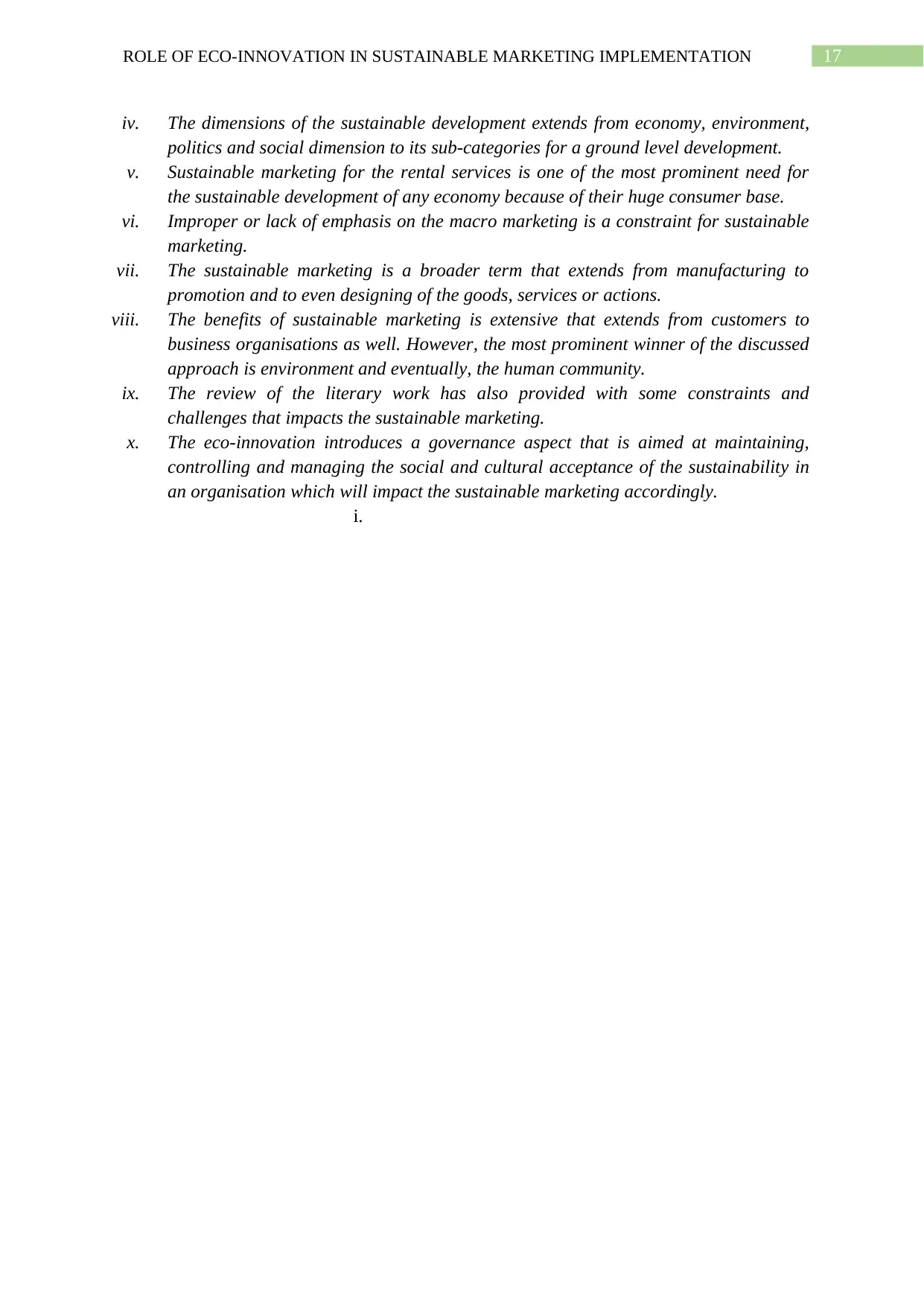
17ROLE OF ECO-INNOVATION IN SUSTAINABLE MARKETING IMPLEMENTATION
iv. The dimensions of the sustainable development extends from economy, environment,
politics and social dimension to its sub-categories for a ground level development.
v. Sustainable marketing for the rental services is one of the most prominent need for
the sustainable development of any economy because of their huge consumer base.
vi. Improper or lack of emphasis on the macro marketing is a constraint for sustainable
marketing.
vii. The sustainable marketing is a broader term that extends from manufacturing to
promotion and to even designing of the goods, services or actions.
viii. The benefits of sustainable marketing is extensive that extends from customers to
business organisations as well. However, the most prominent winner of the discussed
approach is environment and eventually, the human community.
ix. The review of the literary work has also provided with some constraints and
challenges that impacts the sustainable marketing.
x. The eco-innovation introduces a governance aspect that is aimed at maintaining,
controlling and managing the social and cultural acceptance of the sustainability in
an organisation which will impact the sustainable marketing accordingly.
i.
iv. The dimensions of the sustainable development extends from economy, environment,
politics and social dimension to its sub-categories for a ground level development.
v. Sustainable marketing for the rental services is one of the most prominent need for
the sustainable development of any economy because of their huge consumer base.
vi. Improper or lack of emphasis on the macro marketing is a constraint for sustainable
marketing.
vii. The sustainable marketing is a broader term that extends from manufacturing to
promotion and to even designing of the goods, services or actions.
viii. The benefits of sustainable marketing is extensive that extends from customers to
business organisations as well. However, the most prominent winner of the discussed
approach is environment and eventually, the human community.
ix. The review of the literary work has also provided with some constraints and
challenges that impacts the sustainable marketing.
x. The eco-innovation introduces a governance aspect that is aimed at maintaining,
controlling and managing the social and cultural acceptance of the sustainability in
an organisation which will impact the sustainable marketing accordingly.
i.
You're viewing a preview
Unlock full access by subscribing today!
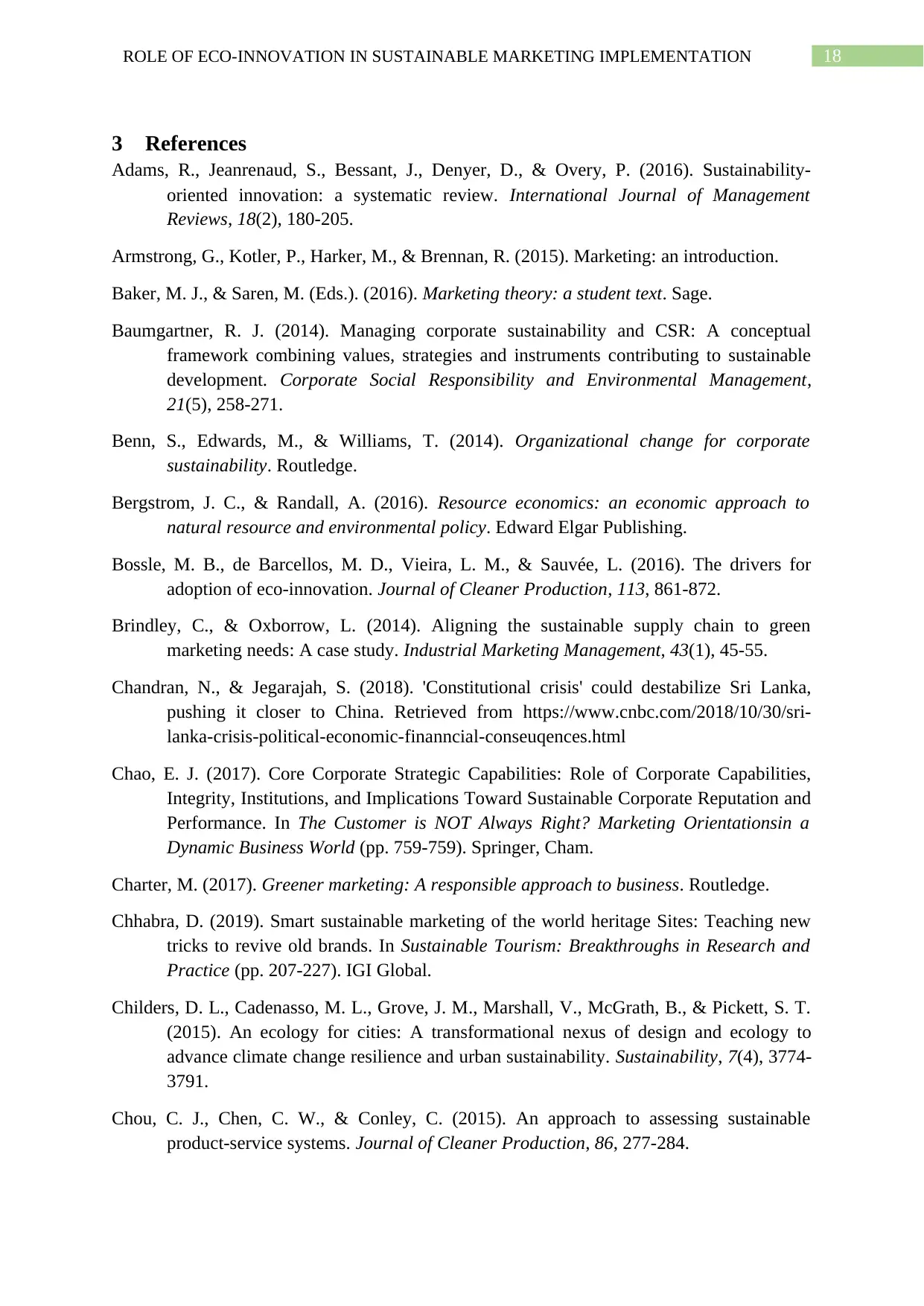
18ROLE OF ECO-INNOVATION IN SUSTAINABLE MARKETING IMPLEMENTATION
3 References
Adams, R., Jeanrenaud, S., Bessant, J., Denyer, D., & Overy, P. (2016). Sustainability‐
oriented innovation: a systematic review. International Journal of Management
Reviews, 18(2), 180-205.
Armstrong, G., Kotler, P., Harker, M., & Brennan, R. (2015). Marketing: an introduction.
Baker, M. J., & Saren, M. (Eds.). (2016). Marketing theory: a student text. Sage.
Baumgartner, R. J. (2014). Managing corporate sustainability and CSR: A conceptual
framework combining values, strategies and instruments contributing to sustainable
development. Corporate Social Responsibility and Environmental Management,
21(5), 258-271.
Benn, S., Edwards, M., & Williams, T. (2014). Organizational change for corporate
sustainability. Routledge.
Bergstrom, J. C., & Randall, A. (2016). Resource economics: an economic approach to
natural resource and environmental policy. Edward Elgar Publishing.
Bossle, M. B., de Barcellos, M. D., Vieira, L. M., & Sauvée, L. (2016). The drivers for
adoption of eco-innovation. Journal of Cleaner Production, 113, 861-872.
Brindley, C., & Oxborrow, L. (2014). Aligning the sustainable supply chain to green
marketing needs: A case study. Industrial Marketing Management, 43(1), 45-55.
Chandran, N., & Jegarajah, S. (2018). 'Constitutional crisis' could destabilize Sri Lanka,
pushing it closer to China. Retrieved from https://www.cnbc.com/2018/10/30/sri-
lanka-crisis-political-economic-finanncial-conseuqences.html
Chao, E. J. (2017). Core Corporate Strategic Capabilities: Role of Corporate Capabilities,
Integrity, Institutions, and Implications Toward Sustainable Corporate Reputation and
Performance. In The Customer is NOT Always Right? Marketing Orientationsin a
Dynamic Business World (pp. 759-759). Springer, Cham.
Charter, M. (2017). Greener marketing: A responsible approach to business. Routledge.
Chhabra, D. (2019). Smart sustainable marketing of the world heritage Sites: Teaching new
tricks to revive old brands. In Sustainable Tourism: Breakthroughs in Research and
Practice (pp. 207-227). IGI Global.
Childers, D. L., Cadenasso, M. L., Grove, J. M., Marshall, V., McGrath, B., & Pickett, S. T.
(2015). An ecology for cities: A transformational nexus of design and ecology to
advance climate change resilience and urban sustainability. Sustainability, 7(4), 3774-
3791.
Chou, C. J., Chen, C. W., & Conley, C. (2015). An approach to assessing sustainable
product-service systems. Journal of Cleaner Production, 86, 277-284.
3 References
Adams, R., Jeanrenaud, S., Bessant, J., Denyer, D., & Overy, P. (2016). Sustainability‐
oriented innovation: a systematic review. International Journal of Management
Reviews, 18(2), 180-205.
Armstrong, G., Kotler, P., Harker, M., & Brennan, R. (2015). Marketing: an introduction.
Baker, M. J., & Saren, M. (Eds.). (2016). Marketing theory: a student text. Sage.
Baumgartner, R. J. (2014). Managing corporate sustainability and CSR: A conceptual
framework combining values, strategies and instruments contributing to sustainable
development. Corporate Social Responsibility and Environmental Management,
21(5), 258-271.
Benn, S., Edwards, M., & Williams, T. (2014). Organizational change for corporate
sustainability. Routledge.
Bergstrom, J. C., & Randall, A. (2016). Resource economics: an economic approach to
natural resource and environmental policy. Edward Elgar Publishing.
Bossle, M. B., de Barcellos, M. D., Vieira, L. M., & Sauvée, L. (2016). The drivers for
adoption of eco-innovation. Journal of Cleaner Production, 113, 861-872.
Brindley, C., & Oxborrow, L. (2014). Aligning the sustainable supply chain to green
marketing needs: A case study. Industrial Marketing Management, 43(1), 45-55.
Chandran, N., & Jegarajah, S. (2018). 'Constitutional crisis' could destabilize Sri Lanka,
pushing it closer to China. Retrieved from https://www.cnbc.com/2018/10/30/sri-
lanka-crisis-political-economic-finanncial-conseuqences.html
Chao, E. J. (2017). Core Corporate Strategic Capabilities: Role of Corporate Capabilities,
Integrity, Institutions, and Implications Toward Sustainable Corporate Reputation and
Performance. In The Customer is NOT Always Right? Marketing Orientationsin a
Dynamic Business World (pp. 759-759). Springer, Cham.
Charter, M. (2017). Greener marketing: A responsible approach to business. Routledge.
Chhabra, D. (2019). Smart sustainable marketing of the world heritage Sites: Teaching new
tricks to revive old brands. In Sustainable Tourism: Breakthroughs in Research and
Practice (pp. 207-227). IGI Global.
Childers, D. L., Cadenasso, M. L., Grove, J. M., Marshall, V., McGrath, B., & Pickett, S. T.
(2015). An ecology for cities: A transformational nexus of design and ecology to
advance climate change resilience and urban sustainability. Sustainability, 7(4), 3774-
3791.
Chou, C. J., Chen, C. W., & Conley, C. (2015). An approach to assessing sustainable
product-service systems. Journal of Cleaner Production, 86, 277-284.
Paraphrase This Document
Need a fresh take? Get an instant paraphrase of this document with our AI Paraphraser
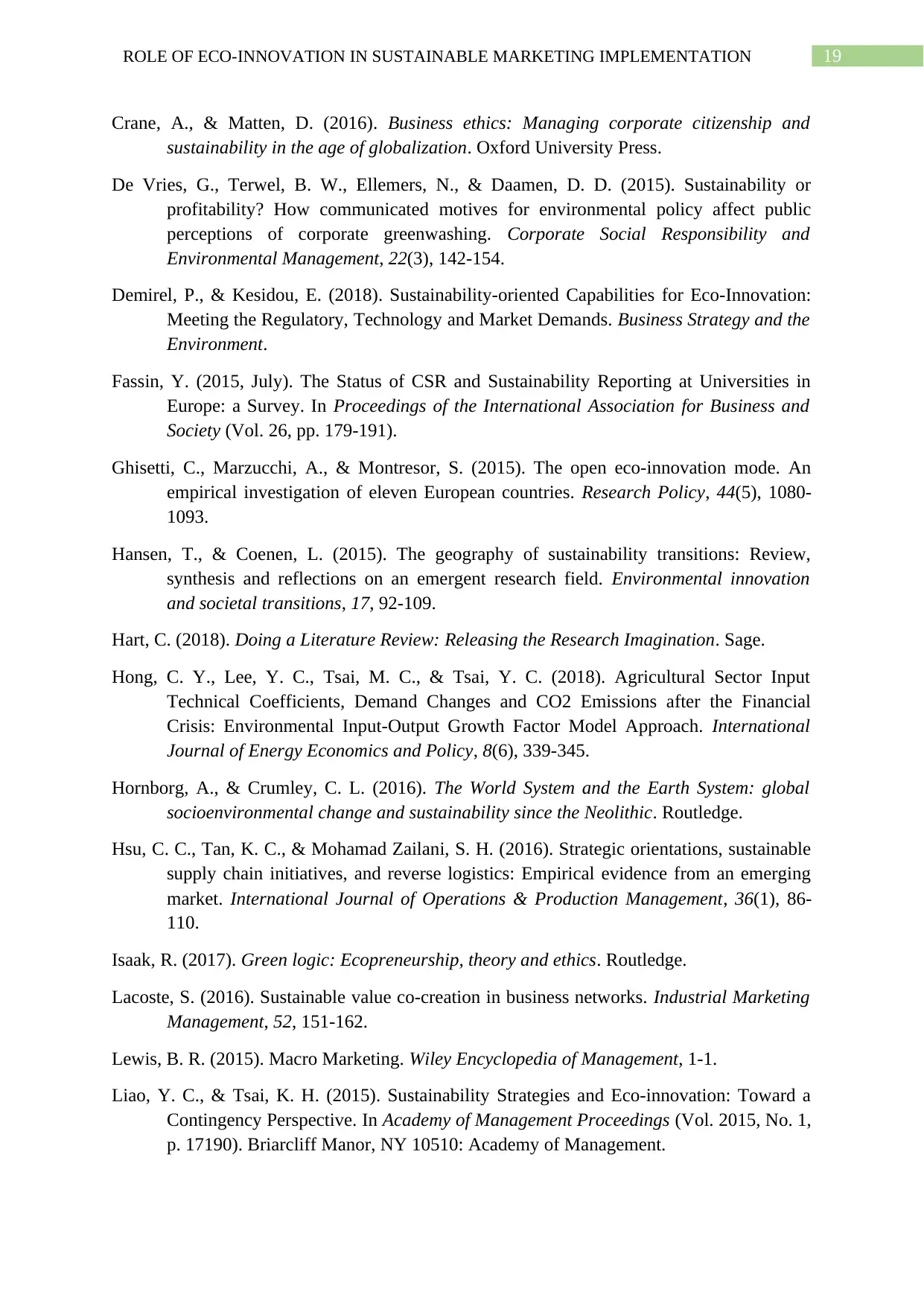
19ROLE OF ECO-INNOVATION IN SUSTAINABLE MARKETING IMPLEMENTATION
Crane, A., & Matten, D. (2016). Business ethics: Managing corporate citizenship and
sustainability in the age of globalization. Oxford University Press.
De Vries, G., Terwel, B. W., Ellemers, N., & Daamen, D. D. (2015). Sustainability or
profitability? How communicated motives for environmental policy affect public
perceptions of corporate greenwashing. Corporate Social Responsibility and
Environmental Management, 22(3), 142-154.
Demirel, P., & Kesidou, E. (2018). Sustainability-oriented Capabilities for Eco-Innovation:
Meeting the Regulatory, Technology and Market Demands. Business Strategy and the
Environment.
Fassin, Y. (2015, July). The Status of CSR and Sustainability Reporting at Universities in
Europe: a Survey. In Proceedings of the International Association for Business and
Society (Vol. 26, pp. 179-191).
Ghisetti, C., Marzucchi, A., & Montresor, S. (2015). The open eco-innovation mode. An
empirical investigation of eleven European countries. Research Policy, 44(5), 1080-
1093.
Hansen, T., & Coenen, L. (2015). The geography of sustainability transitions: Review,
synthesis and reflections on an emergent research field. Environmental innovation
and societal transitions, 17, 92-109.
Hart, C. (2018). Doing a Literature Review: Releasing the Research Imagination. Sage.
Hong, C. Y., Lee, Y. C., Tsai, M. C., & Tsai, Y. C. (2018). Agricultural Sector Input
Technical Coefficients, Demand Changes and CO2 Emissions after the Financial
Crisis: Environmental Input-Output Growth Factor Model Approach. International
Journal of Energy Economics and Policy, 8(6), 339-345.
Hornborg, A., & Crumley, C. L. (2016). The World System and the Earth System: global
socioenvironmental change and sustainability since the Neolithic. Routledge.
Hsu, C. C., Tan, K. C., & Mohamad Zailani, S. H. (2016). Strategic orientations, sustainable
supply chain initiatives, and reverse logistics: Empirical evidence from an emerging
market. International Journal of Operations & Production Management, 36(1), 86-
110.
Isaak, R. (2017). Green logic: Ecopreneurship, theory and ethics. Routledge.
Lacoste, S. (2016). Sustainable value co-creation in business networks. Industrial Marketing
Management, 52, 151-162.
Lewis, B. R. (2015). Macro Marketing. Wiley Encyclopedia of Management, 1-1.
Liao, Y. C., & Tsai, K. H. (2015). Sustainability Strategies and Eco-innovation: Toward a
Contingency Perspective. In Academy of Management Proceedings (Vol. 2015, No. 1,
p. 17190). Briarcliff Manor, NY 10510: Academy of Management.
Crane, A., & Matten, D. (2016). Business ethics: Managing corporate citizenship and
sustainability in the age of globalization. Oxford University Press.
De Vries, G., Terwel, B. W., Ellemers, N., & Daamen, D. D. (2015). Sustainability or
profitability? How communicated motives for environmental policy affect public
perceptions of corporate greenwashing. Corporate Social Responsibility and
Environmental Management, 22(3), 142-154.
Demirel, P., & Kesidou, E. (2018). Sustainability-oriented Capabilities for Eco-Innovation:
Meeting the Regulatory, Technology and Market Demands. Business Strategy and the
Environment.
Fassin, Y. (2015, July). The Status of CSR and Sustainability Reporting at Universities in
Europe: a Survey. In Proceedings of the International Association for Business and
Society (Vol. 26, pp. 179-191).
Ghisetti, C., Marzucchi, A., & Montresor, S. (2015). The open eco-innovation mode. An
empirical investigation of eleven European countries. Research Policy, 44(5), 1080-
1093.
Hansen, T., & Coenen, L. (2015). The geography of sustainability transitions: Review,
synthesis and reflections on an emergent research field. Environmental innovation
and societal transitions, 17, 92-109.
Hart, C. (2018). Doing a Literature Review: Releasing the Research Imagination. Sage.
Hong, C. Y., Lee, Y. C., Tsai, M. C., & Tsai, Y. C. (2018). Agricultural Sector Input
Technical Coefficients, Demand Changes and CO2 Emissions after the Financial
Crisis: Environmental Input-Output Growth Factor Model Approach. International
Journal of Energy Economics and Policy, 8(6), 339-345.
Hornborg, A., & Crumley, C. L. (2016). The World System and the Earth System: global
socioenvironmental change and sustainability since the Neolithic. Routledge.
Hsu, C. C., Tan, K. C., & Mohamad Zailani, S. H. (2016). Strategic orientations, sustainable
supply chain initiatives, and reverse logistics: Empirical evidence from an emerging
market. International Journal of Operations & Production Management, 36(1), 86-
110.
Isaak, R. (2017). Green logic: Ecopreneurship, theory and ethics. Routledge.
Lacoste, S. (2016). Sustainable value co-creation in business networks. Industrial Marketing
Management, 52, 151-162.
Lewis, B. R. (2015). Macro Marketing. Wiley Encyclopedia of Management, 1-1.
Liao, Y. C., & Tsai, K. H. (2015). Sustainability Strategies and Eco-innovation: Toward a
Contingency Perspective. In Academy of Management Proceedings (Vol. 2015, No. 1,
p. 17190). Briarcliff Manor, NY 10510: Academy of Management.
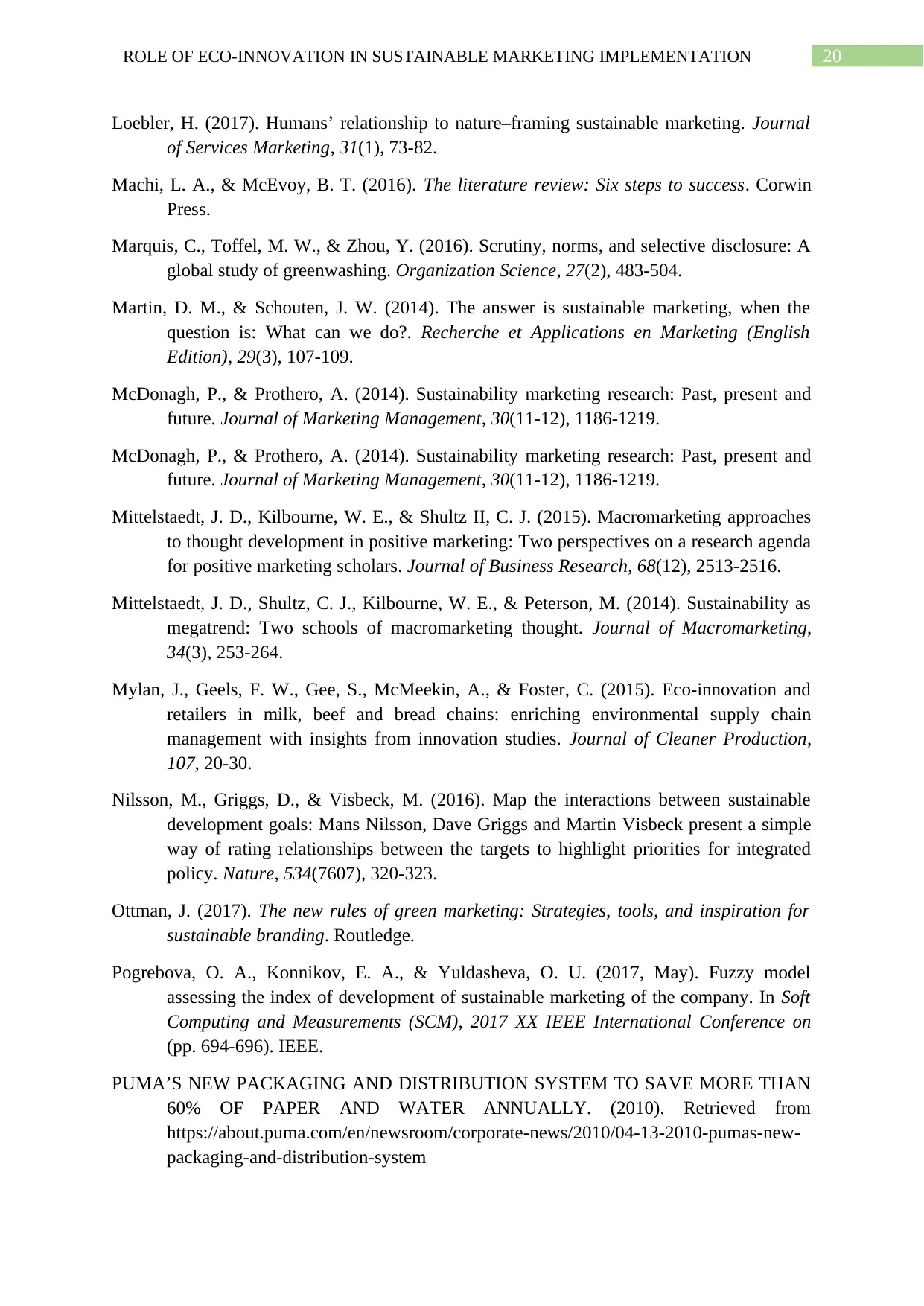
20ROLE OF ECO-INNOVATION IN SUSTAINABLE MARKETING IMPLEMENTATION
Loebler, H. (2017). Humans’ relationship to nature–framing sustainable marketing. Journal
of Services Marketing, 31(1), 73-82.
Machi, L. A., & McEvoy, B. T. (2016). The literature review: Six steps to success. Corwin
Press.
Marquis, C., Toffel, M. W., & Zhou, Y. (2016). Scrutiny, norms, and selective disclosure: A
global study of greenwashing. Organization Science, 27(2), 483-504.
Martin, D. M., & Schouten, J. W. (2014). The answer is sustainable marketing, when the
question is: What can we do?. Recherche et Applications en Marketing (English
Edition), 29(3), 107-109.
McDonagh, P., & Prothero, A. (2014). Sustainability marketing research: Past, present and
future. Journal of Marketing Management, 30(11-12), 1186-1219.
McDonagh, P., & Prothero, A. (2014). Sustainability marketing research: Past, present and
future. Journal of Marketing Management, 30(11-12), 1186-1219.
Mittelstaedt, J. D., Kilbourne, W. E., & Shultz II, C. J. (2015). Macromarketing approaches
to thought development in positive marketing: Two perspectives on a research agenda
for positive marketing scholars. Journal of Business Research, 68(12), 2513-2516.
Mittelstaedt, J. D., Shultz, C. J., Kilbourne, W. E., & Peterson, M. (2014). Sustainability as
megatrend: Two schools of macromarketing thought. Journal of Macromarketing,
34(3), 253-264.
Mylan, J., Geels, F. W., Gee, S., McMeekin, A., & Foster, C. (2015). Eco-innovation and
retailers in milk, beef and bread chains: enriching environmental supply chain
management with insights from innovation studies. Journal of Cleaner Production,
107, 20-30.
Nilsson, M., Griggs, D., & Visbeck, M. (2016). Map the interactions between sustainable
development goals: Mans Nilsson, Dave Griggs and Martin Visbeck present a simple
way of rating relationships between the targets to highlight priorities for integrated
policy. Nature, 534(7607), 320-323.
Ottman, J. (2017). The new rules of green marketing: Strategies, tools, and inspiration for
sustainable branding. Routledge.
Pogrebova, O. A., Konnikov, E. A., & Yuldasheva, O. U. (2017, May). Fuzzy model
assessing the index of development of sustainable marketing of the company. In Soft
Computing and Measurements (SCM), 2017 XX IEEE International Conference on
(pp. 694-696). IEEE.
PUMA’S NEW PACKAGING AND DISTRIBUTION SYSTEM TO SAVE MORE THAN
60% OF PAPER AND WATER ANNUALLY. (2010). Retrieved from
https://about.puma.com/en/newsroom/corporate-news/2010/04-13-2010-pumas-new-
packaging-and-distribution-system
Loebler, H. (2017). Humans’ relationship to nature–framing sustainable marketing. Journal
of Services Marketing, 31(1), 73-82.
Machi, L. A., & McEvoy, B. T. (2016). The literature review: Six steps to success. Corwin
Press.
Marquis, C., Toffel, M. W., & Zhou, Y. (2016). Scrutiny, norms, and selective disclosure: A
global study of greenwashing. Organization Science, 27(2), 483-504.
Martin, D. M., & Schouten, J. W. (2014). The answer is sustainable marketing, when the
question is: What can we do?. Recherche et Applications en Marketing (English
Edition), 29(3), 107-109.
McDonagh, P., & Prothero, A. (2014). Sustainability marketing research: Past, present and
future. Journal of Marketing Management, 30(11-12), 1186-1219.
McDonagh, P., & Prothero, A. (2014). Sustainability marketing research: Past, present and
future. Journal of Marketing Management, 30(11-12), 1186-1219.
Mittelstaedt, J. D., Kilbourne, W. E., & Shultz II, C. J. (2015). Macromarketing approaches
to thought development in positive marketing: Two perspectives on a research agenda
for positive marketing scholars. Journal of Business Research, 68(12), 2513-2516.
Mittelstaedt, J. D., Shultz, C. J., Kilbourne, W. E., & Peterson, M. (2014). Sustainability as
megatrend: Two schools of macromarketing thought. Journal of Macromarketing,
34(3), 253-264.
Mylan, J., Geels, F. W., Gee, S., McMeekin, A., & Foster, C. (2015). Eco-innovation and
retailers in milk, beef and bread chains: enriching environmental supply chain
management with insights from innovation studies. Journal of Cleaner Production,
107, 20-30.
Nilsson, M., Griggs, D., & Visbeck, M. (2016). Map the interactions between sustainable
development goals: Mans Nilsson, Dave Griggs and Martin Visbeck present a simple
way of rating relationships between the targets to highlight priorities for integrated
policy. Nature, 534(7607), 320-323.
Ottman, J. (2017). The new rules of green marketing: Strategies, tools, and inspiration for
sustainable branding. Routledge.
Pogrebova, O. A., Konnikov, E. A., & Yuldasheva, O. U. (2017, May). Fuzzy model
assessing the index of development of sustainable marketing of the company. In Soft
Computing and Measurements (SCM), 2017 XX IEEE International Conference on
(pp. 694-696). IEEE.
PUMA’S NEW PACKAGING AND DISTRIBUTION SYSTEM TO SAVE MORE THAN
60% OF PAPER AND WATER ANNUALLY. (2010). Retrieved from
https://about.puma.com/en/newsroom/corporate-news/2010/04-13-2010-pumas-new-
packaging-and-distribution-system
You're viewing a preview
Unlock full access by subscribing today!
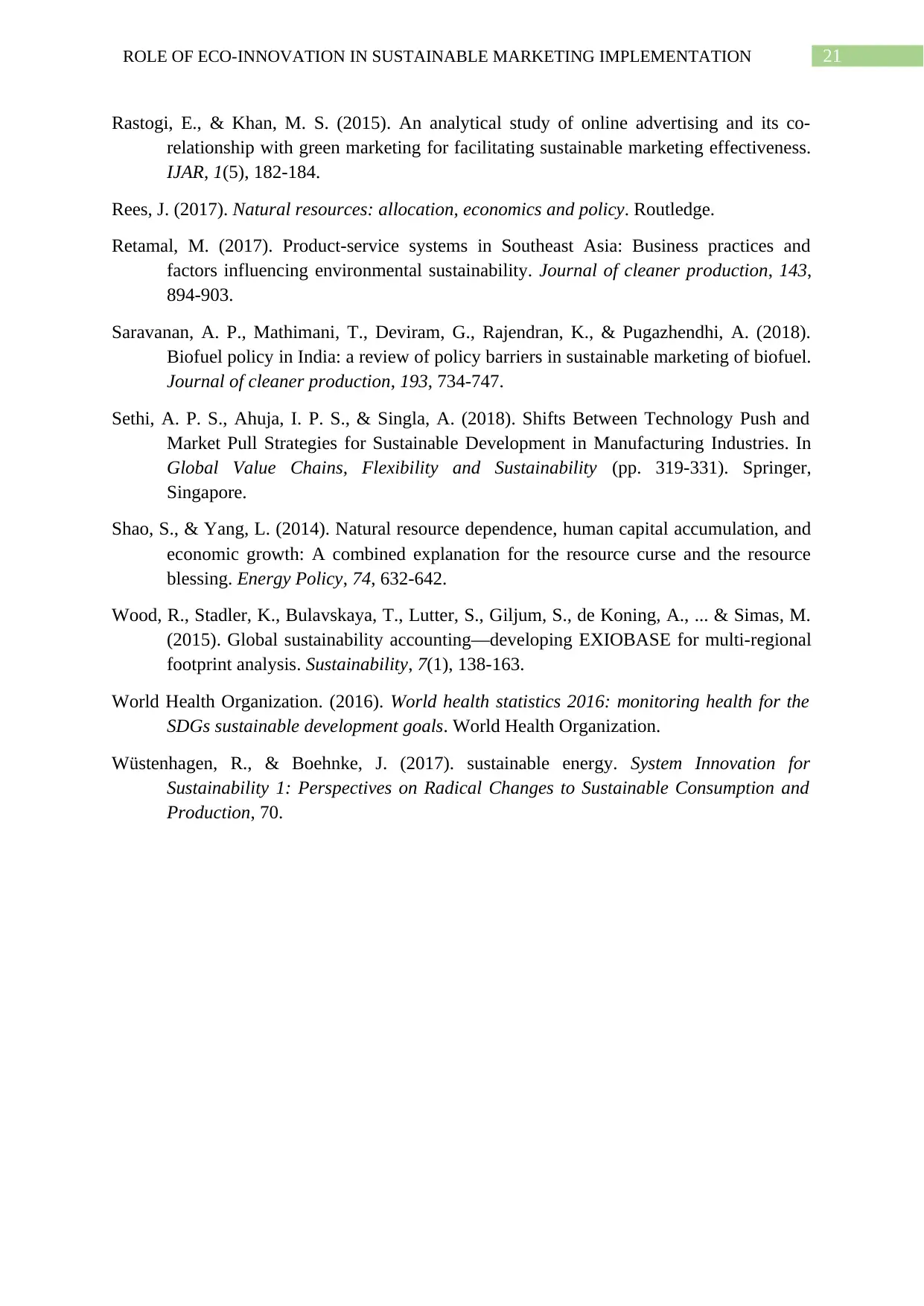
21ROLE OF ECO-INNOVATION IN SUSTAINABLE MARKETING IMPLEMENTATION
Rastogi, E., & Khan, M. S. (2015). An analytical study of online advertising and its co-
relationship with green marketing for facilitating sustainable marketing effectiveness.
IJAR, 1(5), 182-184.
Rees, J. (2017). Natural resources: allocation, economics and policy. Routledge.
Retamal, M. (2017). Product-service systems in Southeast Asia: Business practices and
factors influencing environmental sustainability. Journal of cleaner production, 143,
894-903.
Saravanan, A. P., Mathimani, T., Deviram, G., Rajendran, K., & Pugazhendhi, A. (2018).
Biofuel policy in India: a review of policy barriers in sustainable marketing of biofuel.
Journal of cleaner production, 193, 734-747.
Sethi, A. P. S., Ahuja, I. P. S., & Singla, A. (2018). Shifts Between Technology Push and
Market Pull Strategies for Sustainable Development in Manufacturing Industries. In
Global Value Chains, Flexibility and Sustainability (pp. 319-331). Springer,
Singapore.
Shao, S., & Yang, L. (2014). Natural resource dependence, human capital accumulation, and
economic growth: A combined explanation for the resource curse and the resource
blessing. Energy Policy, 74, 632-642.
Wood, R., Stadler, K., Bulavskaya, T., Lutter, S., Giljum, S., de Koning, A., ... & Simas, M.
(2015). Global sustainability accounting—developing EXIOBASE for multi-regional
footprint analysis. Sustainability, 7(1), 138-163.
World Health Organization. (2016). World health statistics 2016: monitoring health for the
SDGs sustainable development goals. World Health Organization.
Wüstenhagen, R., & Boehnke, J. (2017). sustainable energy. System Innovation for
Sustainability 1: Perspectives on Radical Changes to Sustainable Consumption and
Production, 70.
Rastogi, E., & Khan, M. S. (2015). An analytical study of online advertising and its co-
relationship with green marketing for facilitating sustainable marketing effectiveness.
IJAR, 1(5), 182-184.
Rees, J. (2017). Natural resources: allocation, economics and policy. Routledge.
Retamal, M. (2017). Product-service systems in Southeast Asia: Business practices and
factors influencing environmental sustainability. Journal of cleaner production, 143,
894-903.
Saravanan, A. P., Mathimani, T., Deviram, G., Rajendran, K., & Pugazhendhi, A. (2018).
Biofuel policy in India: a review of policy barriers in sustainable marketing of biofuel.
Journal of cleaner production, 193, 734-747.
Sethi, A. P. S., Ahuja, I. P. S., & Singla, A. (2018). Shifts Between Technology Push and
Market Pull Strategies for Sustainable Development in Manufacturing Industries. In
Global Value Chains, Flexibility and Sustainability (pp. 319-331). Springer,
Singapore.
Shao, S., & Yang, L. (2014). Natural resource dependence, human capital accumulation, and
economic growth: A combined explanation for the resource curse and the resource
blessing. Energy Policy, 74, 632-642.
Wood, R., Stadler, K., Bulavskaya, T., Lutter, S., Giljum, S., de Koning, A., ... & Simas, M.
(2015). Global sustainability accounting—developing EXIOBASE for multi-regional
footprint analysis. Sustainability, 7(1), 138-163.
World Health Organization. (2016). World health statistics 2016: monitoring health for the
SDGs sustainable development goals. World Health Organization.
Wüstenhagen, R., & Boehnke, J. (2017). sustainable energy. System Innovation for
Sustainability 1: Perspectives on Radical Changes to Sustainable Consumption and
Production, 70.
1 out of 22
Related Documents
Your All-in-One AI-Powered Toolkit for Academic Success.
+13062052269
info@desklib.com
Available 24*7 on WhatsApp / Email
![[object Object]](/_next/static/media/star-bottom.7253800d.svg)
Unlock your academic potential
© 2024 | Zucol Services PVT LTD | All rights reserved.




